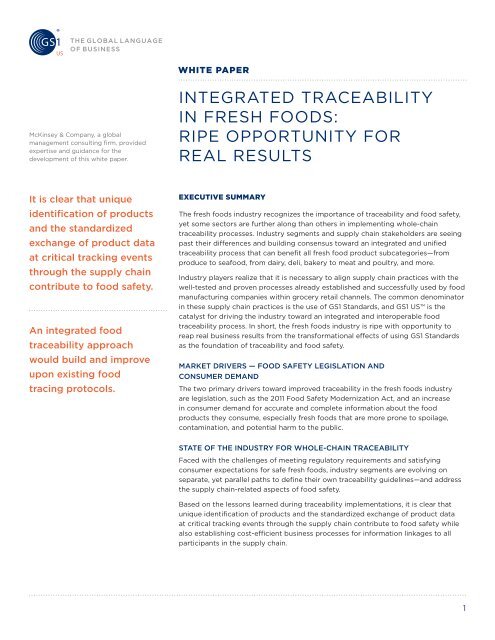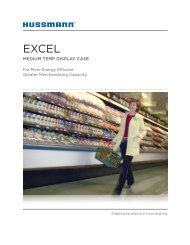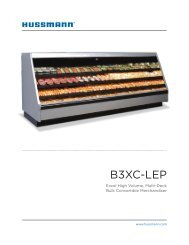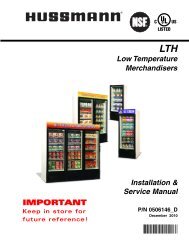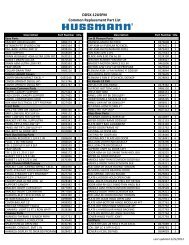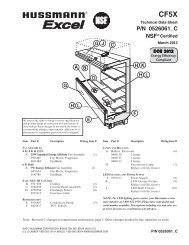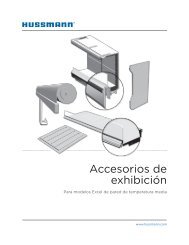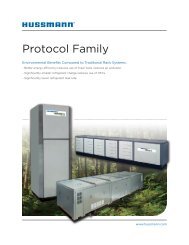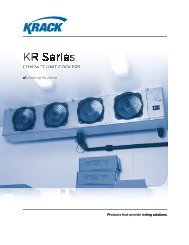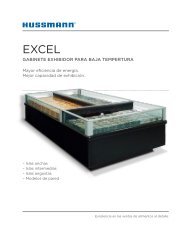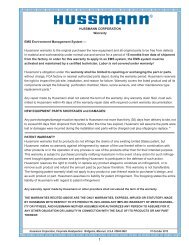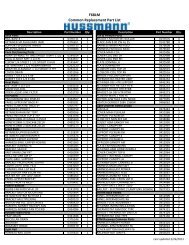integrated traceability in fresh foods: ripe opportunity for ... - GS1 US
integrated traceability in fresh foods: ripe opportunity for ... - GS1 US
integrated traceability in fresh foods: ripe opportunity for ... - GS1 US
Create successful ePaper yourself
Turn your PDF publications into a flip-book with our unique Google optimized e-Paper software.
THE GLOBAL LANGUAGE<br />
OF B<strong>US</strong>INESS<br />
White paper<br />
McK<strong>in</strong>sey & Company, a global<br />
management consult<strong>in</strong>g firm, provided<br />
expertise and guidance <strong>for</strong> the<br />
development of this white paper.<br />
<strong><strong>in</strong>tegrated</strong> <strong>traceability</strong><br />
<strong>in</strong> <strong>fresh</strong> <strong>foods</strong>:<br />
Ripe <strong>opportunity</strong> <strong>for</strong><br />
real Results<br />
It is clear that unique<br />
identification of products<br />
and the standardized<br />
exchange of product data<br />
at critical track<strong>in</strong>g events<br />
through the supply cha<strong>in</strong><br />
contribute to food safety.<br />
An <strong><strong>in</strong>tegrated</strong> food<br />
<strong>traceability</strong> approach<br />
would build and improve<br />
upon exist<strong>in</strong>g food<br />
trac<strong>in</strong>g protocols.<br />
Executive Summary<br />
The <strong>fresh</strong> <strong>foods</strong> <strong>in</strong>dustry recognizes the importance of <strong>traceability</strong> and food safety,<br />
yet some sectors are further along than others <strong>in</strong> implement<strong>in</strong>g whole-cha<strong>in</strong><br />
<strong>traceability</strong> processes. Industry segments and supply cha<strong>in</strong> stakeholders are see<strong>in</strong>g<br />
past their differences and build<strong>in</strong>g consensus toward an <strong><strong>in</strong>tegrated</strong> and unified<br />
<strong>traceability</strong> process that can benefit all <strong>fresh</strong> food product subcategories—from<br />
produce to seafood, from dairy, deli, bakery to meat and poultry, and more.<br />
Industry players realize that it is necessary to align supply cha<strong>in</strong> practices with the<br />
well-tested and proven processes already established and successfully used by food<br />
manufactur<strong>in</strong>g companies with<strong>in</strong> grocery retail channels. The common denom<strong>in</strong>ator<br />
<strong>in</strong> these supply cha<strong>in</strong> practices is the use of <strong>GS1</strong> Standards, and <strong>GS1</strong> <strong>US</strong> is the<br />
catalyst <strong>for</strong> driv<strong>in</strong>g the <strong>in</strong>dustry toward an <strong><strong>in</strong>tegrated</strong> and <strong>in</strong>teroperable food<br />
<strong>traceability</strong> process. In short, the <strong>fresh</strong> <strong>foods</strong> <strong>in</strong>dustry is <strong>ripe</strong> with <strong>opportunity</strong> to<br />
reap real bus<strong>in</strong>ess results from the trans<strong>for</strong>mational effects of us<strong>in</strong>g <strong>GS1</strong> Standards<br />
as the foundation of <strong>traceability</strong> and food safety.<br />
MARKET DRIVERS — FOOD SAFETY LEGISLATION AND<br />
CONSUMER DEMAND<br />
The two primary drivers toward improved <strong>traceability</strong> <strong>in</strong> the <strong>fresh</strong> <strong>foods</strong> <strong>in</strong>dustry<br />
are legislation, such as the 2011 Food Safety Modernization Act, and an <strong>in</strong>crease<br />
<strong>in</strong> consumer demand <strong>for</strong> accurate and complete <strong>in</strong><strong>for</strong>mation about the food<br />
products they consume, especially <strong>fresh</strong> <strong>foods</strong> that are more prone to spoilage,<br />
contam<strong>in</strong>ation, and potential harm to the public.<br />
STATE OF THE IND<strong>US</strong>TRY FOR WHOLE-CHAIN TRACEABILITY<br />
Faced with the challenges of meet<strong>in</strong>g regulatory requirements and satisfy<strong>in</strong>g<br />
consumer expectations <strong>for</strong> safe <strong>fresh</strong> <strong>foods</strong>, <strong>in</strong>dustry segments are evolv<strong>in</strong>g on<br />
separate, yet parallel paths to def<strong>in</strong>e their own <strong>traceability</strong> guidel<strong>in</strong>es—and address<br />
the supply cha<strong>in</strong>-related aspects of food safety.<br />
Based on the lessons learned dur<strong>in</strong>g <strong>traceability</strong> implementations, it is clear that<br />
unique identification of products and the standardized exchange of product data<br />
at critical track<strong>in</strong>g events through the supply cha<strong>in</strong> contribute to food safety while<br />
also establish<strong>in</strong>g cost-efficient bus<strong>in</strong>ess processes <strong>for</strong> <strong>in</strong><strong>for</strong>mation l<strong>in</strong>kages to all<br />
participants <strong>in</strong> the supply cha<strong>in</strong>.<br />
1
Integrated <strong>traceability</strong> has the potential<br />
to trans<strong>for</strong>m the <strong>fresh</strong> <strong>foods</strong> supply cha<strong>in</strong>.<br />
IND<strong>US</strong>TRY PARTICIPATION AND BUYER<br />
OPERATIONS STUDY<br />
Throughout the <strong>fresh</strong> <strong>foods</strong> <strong>in</strong>dustry, trad<strong>in</strong>g partners<br />
generally agree that a standardized framework is needed to<br />
m<strong>in</strong>imize the f<strong>in</strong>ancial impact of food recalls and optimize<br />
preparedness <strong>in</strong> order to address safety concerns.<br />
The Produce Traceability Initiative is the most visible example<br />
of a proactive, <strong>in</strong>dustry-led ef<strong>for</strong>t guid<strong>in</strong>g stakeholders—<br />
represent<strong>in</strong>g every part of the produce supply cha<strong>in</strong>—toward<br />
case-level <strong>traceability</strong>. This discipl<strong>in</strong>ed cross-<strong>in</strong>dustry<br />
approach has proven to be an effective methodology <strong>for</strong><br />
driv<strong>in</strong>g change and is be<strong>in</strong>g recognized by other sectors as<br />
the “go-to” process <strong>for</strong> <strong>traceability</strong> implementation.<br />
Based on the Buyer Operations Study conducted by <strong>GS1</strong><br />
<strong>US</strong> with meat, seafood, and produce suppliers—along with<br />
distributors, retailers, and restaurant operators—f<strong>in</strong>d<strong>in</strong>gs<br />
confirm that improv<strong>in</strong>g <strong>traceability</strong> processes results <strong>in</strong><br />
enhanced food safety, reduced costs, and <strong>in</strong>cremental<br />
<strong>in</strong>creases <strong>in</strong> revenue generation.<br />
LEVERAGING <strong>GS1</strong> STANDARDS FOR AN INTEGRATED<br />
FRESH FOOD TRACEABILITY APPROACH<br />
An effective <strong><strong>in</strong>tegrated</strong> <strong>traceability</strong> process needs to be<br />
built on a standardized approach to product and location<br />
identification while also rema<strong>in</strong><strong>in</strong>g flexible <strong>for</strong> the various<br />
supply cha<strong>in</strong> roles and responsibilities with<strong>in</strong> the ecosystem.<br />
While many trad<strong>in</strong>g partners already have l<strong>in</strong>kages to<br />
external systems and processes <strong>for</strong> some level of product<br />
<strong>traceability</strong>, the next step toward an <strong><strong>in</strong>tegrated</strong> approach is<br />
to identify opportunities <strong>for</strong> <strong>in</strong>teroperability between <strong>in</strong>ternal<br />
and external processes across the entire food <strong>in</strong>dustry.<br />
An <strong><strong>in</strong>tegrated</strong> food <strong>traceability</strong> approach would build and<br />
improve upon exist<strong>in</strong>g food trac<strong>in</strong>g protocols, like the<br />
Produce Traceability Initiative, and utilize exist<strong>in</strong>g trac<strong>in</strong>g<br />
tools, such as Critical Track<strong>in</strong>g Events (CTEs) and Key<br />
Data Elements (KDEs). This would provide benefits to all,<br />
<strong>in</strong>clud<strong>in</strong>g:<br />
• Improved food safety via precise and efficient recalls<br />
• New operational efficiencies ga<strong>in</strong>ed by all members of<br />
the supply cha<strong>in</strong><br />
• Potential revenue growth <strong>for</strong> all <strong>fresh</strong> food categories<br />
The time has come <strong>for</strong> <strong>in</strong>tegrat<strong>in</strong>g whole-cha<strong>in</strong> <strong>traceability</strong><br />
processes across <strong>fresh</strong> food sectors as consumer demands,<br />
public health concerns, and bus<strong>in</strong>ess needs converge.<br />
Industry needs to systematically move toward this <strong><strong>in</strong>tegrated</strong><br />
whole-cha<strong>in</strong> <strong>traceability</strong> process while balanc<strong>in</strong>g regulatory<br />
requirements and implement<strong>in</strong>g proven supply cha<strong>in</strong><br />
management bus<strong>in</strong>ess practices.<br />
Collectively, benefits of an <strong><strong>in</strong>tegrated</strong><br />
<strong>traceability</strong> process could represent<br />
approximately $3 billion to the <strong>fresh</strong><br />
<strong>foods</strong> <strong>in</strong>dustry as a whole.<br />
This approach will require:<br />
• Common language and procedures shared by all <strong>fresh</strong> food<br />
categories through all levels of the supply cha<strong>in</strong><br />
• Interoperable hardware and software solutions<br />
• Full operational/f<strong>in</strong>ancial commitment from all supply cha<strong>in</strong><br />
companies <strong>in</strong> <strong>fresh</strong> <strong>foods</strong><br />
• Clear evidence of benefits <strong>for</strong> all supply cha<strong>in</strong> companies<br />
2
Introduction<br />
Fram<strong>in</strong>g the issue<br />
The <strong>fresh</strong> <strong>foods</strong> <strong>in</strong>dustry is impacted by several economic<br />
and consumer trends, as well as regulatory and public health<br />
issues. These various <strong>for</strong>ces have prompted the <strong>in</strong>dustry to<br />
come together and respond with a collaborative approach.<br />
This paper is <strong>in</strong>tended to provide an overview of the most<br />
important elements that contribute to related supply cha<strong>in</strong><br />
challenges, and outl<strong>in</strong>e an <strong><strong>in</strong>tegrated</strong> <strong>traceability</strong> approach<br />
that all subsectors of the <strong>fresh</strong> <strong>foods</strong> <strong>in</strong>dustry can embrace to<br />
meet the needs of consumers, the bus<strong>in</strong>ess community, and<br />
government.<br />
As the <strong>fresh</strong> food supply cha<strong>in</strong> cont<strong>in</strong>ues<br />
to expand globally, it is becom<strong>in</strong>g more<br />
and more challeng<strong>in</strong>g to effectively<br />
manage food safety emergencies, such<br />
as food recalls.<br />
Current state of the food <strong>in</strong>dustry<br />
Globalization and demand <strong>for</strong> diverse <strong>fresh</strong> food<br />
choices have implications <strong>for</strong> food safety<br />
As the <strong>fresh</strong> food supply cha<strong>in</strong> cont<strong>in</strong>ues to expand globally,<br />
it is becom<strong>in</strong>g more and more challeng<strong>in</strong>g to effectively<br />
manage food safety emergencies, such as food recalls.<br />
Consumers expect to have access to a wide variety of <strong>fresh</strong><br />
food items from suppliers all over the world—result<strong>in</strong>g <strong>in</strong> a<br />
dramatic <strong>in</strong>crease of <strong>fresh</strong> <strong>foods</strong> imports to the United States.<br />
In addition, 94 percent of Americans also expect quick and<br />
accurate trac<strong>in</strong>g of <strong>fresh</strong> food items from production to po<strong>in</strong>t<br />
of sale or service when food safety problems arise. (Source:<br />
Hart Research/Public Op<strong>in</strong>ion Strategies, “Americans’<br />
Attitudes on Food Safety,” 2010.)<br />
Foodborne illnesses from contam<strong>in</strong>ated<br />
food cause approximately $152 billion a<br />
year <strong>in</strong> total healthcare costs.<br />
Cost to <strong>in</strong>dustry - Public health and economic<br />
ramifications of contam<strong>in</strong>ated food<br />
Contam<strong>in</strong>ated food presents significant health-related<br />
damages to the public and economic costs to the <strong>fresh</strong> <strong>foods</strong><br />
<strong>in</strong>dustry. Foodborne illnesses from contam<strong>in</strong>ated food cause<br />
approximately $152 billion a year <strong>in</strong> total healthcare costs.<br />
(Source: Produce Safety Project at Georgetown University.)<br />
Examples of significant recalls <strong>in</strong> recent years <strong>in</strong>clude:<br />
• 2006 sp<strong>in</strong>ach recall cost the sp<strong>in</strong>ach <strong>in</strong>dustry $37 to $74<br />
million <strong>in</strong> immediate economic losses, and $350 million<br />
<strong>in</strong> the year follow<strong>in</strong>g the recall<br />
• A mistaken 2007 Salmonella f<strong>in</strong>d<strong>in</strong>g <strong>in</strong> tomatoes cost<br />
Florida’s tomato <strong>in</strong>dustry $500 million<br />
• 2008 recall of 143 million pounds of beef cost the<br />
Westland/Hallmark meat company about $117 million<br />
• 2009 Salmonella outbreak <strong>in</strong> peanut butter cost U.S.<br />
peanut producers $1 billion<br />
• German bean sprout crisis <strong>in</strong> May 2011 triggered a<br />
consumer panic <strong>in</strong> Europe and was estimated to have<br />
cost farmers $244 million a week<br />
• Listeria-<strong>in</strong>fected cantaloupe recall <strong>in</strong> September 2011<br />
caused hundreds of illnesses and 30 deaths (Sources:<br />
Economic Impact of Recent Food Safety Incidents,<br />
Democratic Policy and Communications Center, United<br />
States Senate; Produce Safety Project funded by Pew<br />
Charitable Trusts, Georgetown University; Impact of Food<br />
Recalls, Guardian Food Services LLC.)<br />
The <strong>fresh</strong> <strong>foods</strong> <strong>in</strong>dustry is now approach<strong>in</strong>g a significant<br />
cross road. Establish<strong>in</strong>g a comprehensive system <strong>for</strong> product<br />
<strong>traceability</strong> and food safety would reduce both the public<br />
health and f<strong>in</strong>ancial damages associated with food recalls.<br />
By record<strong>in</strong>g relevant data <strong>in</strong> a standardized <strong>for</strong>mat at all<br />
major events throughout a product’s path from supplier to<br />
consumer, companies with<strong>in</strong> this system could not only meet<br />
regulatory requirements, but would also have the ability to<br />
react quickly and with surgical precision to recalls.<br />
3
2006 sp<strong>in</strong>ach recall cost the sp<strong>in</strong>ach<br />
<strong>in</strong>dustry $37 to $74 million <strong>in</strong> immediate<br />
economic losses, and $350 million<br />
<strong>in</strong> the year follow<strong>in</strong>g the recall.<br />
Health risks associated with contam<strong>in</strong>ated food result<br />
<strong>in</strong> loss of consumer confidence<br />
Because of shift<strong>in</strong>g demographics (i.e. <strong>in</strong>creas<strong>in</strong>g elderly<br />
population) <strong>in</strong> the United States, a grow<strong>in</strong>g population<br />
of <strong>in</strong>dividuals is especially at risk <strong>for</strong> foodborne illness.<br />
Contam<strong>in</strong>ated <strong>fresh</strong> food items pose serious health risks to<br />
consumers and, <strong>in</strong> extreme cases, can even result <strong>in</strong> death.<br />
As a result of several recalls of potentially dangerous <strong>foods</strong>,<br />
consumers are now demand<strong>in</strong>g that the food <strong>in</strong>dustry<br />
enhance its safety protocols and develop more efficient<br />
processes to be able to react to food safety emergencies<br />
quickly and accurately. In fact, 94 percent of Americans<br />
support the en<strong>for</strong>cement of a trac<strong>in</strong>g system that enables<br />
the Food and Drug Adm<strong>in</strong>istration (FDA) to trace food back<br />
to its orig<strong>in</strong>al source. (Source: Hart Research/Public Op<strong>in</strong>ion<br />
Strategies, “Americans’ Attitudes on Food Safety,” 2010.)<br />
Government agencies have also<br />
expressed concern over the health<br />
and f<strong>in</strong>ancial impact of recent food<br />
recalls, as foodborne illnesses<br />
impact 48 million people a year.<br />
Health and healthcare cost ramifications<br />
Government agencies have also expressed concern over<br />
the health and f<strong>in</strong>ancial impact of recent food recalls, as<br />
foodborne illnesses impact 48 million people a year<br />
(Source: Centers <strong>for</strong> Disease Control and Prevention)<br />
and cost the United States $152 billion <strong>in</strong> healthcare<br />
costs every year (Source: Produce Safety Project at<br />
Georgetown University).<br />
FDA/FSIS <strong>in</strong>vestigation and IFT Task Order 6<br />
There are several pend<strong>in</strong>g bills that would require the Food<br />
Safety and Inspection Service (FSIS) to easily trace the<br />
movement of products. The goal is to better determ<strong>in</strong>e a<br />
product’s source and enable companies to remove potentially<br />
harmful products from the supply cha<strong>in</strong>.<br />
In 2008, FDA and Food Safety and Inspection Service (FSIS)<br />
officials began to <strong>in</strong>itiate <strong>in</strong>vestigations and discussions<br />
about the “need to <strong>in</strong>crease the speed and accuracy of<br />
traceback <strong>in</strong>vestigations and trace <strong>for</strong>ward operations” <strong>in</strong><br />
light of foodborne illness outbreaks.<br />
The FDA contracted the Institute of Food Technologists<br />
(IFT) to identify current and future product trac<strong>in</strong>g systems;<br />
review trac<strong>in</strong>g processes from harvest through process<strong>in</strong>g<br />
and distribution to po<strong>in</strong>ts of consumption; exam<strong>in</strong>e the<br />
accessibility of <strong>in</strong><strong>for</strong>mation to public health and regulatory<br />
officials; and consider the cost implications.<br />
A mock tomato recall was conducted by the IFT and the<br />
suppliers of contam<strong>in</strong>ated products could not be properly<br />
identified. As a result of these f<strong>in</strong>d<strong>in</strong>gs, IFT submitted a full<br />
report to FDA recommend<strong>in</strong>g the concepts—and usage<br />
of— Critical Track<strong>in</strong>g Events (CTEs) and Key Data Elements<br />
(KDEs) <strong>in</strong> support of data capture <strong>for</strong> <strong>traceability</strong>. (See<br />
Bus<strong>in</strong>ess Case section <strong>for</strong> def<strong>in</strong>itions of CTE and KDE.)<br />
Proactive approach taken by <strong>in</strong>dustry<br />
Consumers also want access to more <strong>in</strong><strong>for</strong>mation about<br />
the <strong>fresh</strong> food products they are purchas<strong>in</strong>g from retailers<br />
and at <strong>foods</strong>ervice establishments. In response, some <strong>fresh</strong><br />
<strong>foods</strong> brands allow consumers to access trac<strong>in</strong>g <strong>in</strong><strong>for</strong>mation<br />
<strong>for</strong> their products—from their web or mobile device. While<br />
whole-cha<strong>in</strong> <strong>traceability</strong> does not necessarily mean that<br />
all <strong>in</strong><strong>for</strong>mation from the supply cha<strong>in</strong> will be available to<br />
anyone who wants it, it enables better and more controlled<br />
<strong>in</strong><strong>for</strong>mation shar<strong>in</strong>g between trad<strong>in</strong>g partners.<br />
While the diversity and complexity of the food supply<br />
cha<strong>in</strong> hamper the pace of <strong>in</strong>dustry-wide change, the<br />
damages caused by past food recalls have <strong>in</strong>fluenced<br />
<strong>in</strong>dividual companies, trade associations, and voluntary<br />
groups to better def<strong>in</strong>e their own <strong>traceability</strong> process needs.<br />
Industry sectors are beg<strong>in</strong>n<strong>in</strong>g to see the overall benefits<br />
of <strong>traceability</strong>, and collaboration among stakeholders and<br />
with government agencies is expected to yield a regulatory<br />
framework <strong>in</strong> which all participants can achieve their<br />
varied, yet related, objectives.<br />
Exist<strong>in</strong>g sector-specific <strong>traceability</strong> programs provide a good<br />
foundation <strong>for</strong> an <strong><strong>in</strong>tegrated</strong> whole-cha<strong>in</strong> <strong>traceability</strong> process;<br />
and these sectors are beg<strong>in</strong>n<strong>in</strong>g to work together to leverage<br />
each other’s learn<strong>in</strong>gs.<br />
4
Figure 4: PTI<br />
compliant case label<br />
encod<strong>in</strong>g barcode<br />
with GTIN and<br />
Batch/Lot data <strong>for</strong><br />
<strong>traceability</strong>.<br />
Commodity<br />
Pack Configuration<br />
<strong>GS1</strong>-128 Barcode encoded:<br />
AI 01 = GTIN<br />
AI 10 = Batch/Lot Number<br />
PTI Voice Pick Code<br />
As an example, <strong>in</strong> 2008, The Produce Traceability Initiative<br />
(PTI) was created to address case-level <strong>traceability</strong> with the<br />
active <strong>in</strong>volvement of work<strong>in</strong>g groups represent<strong>in</strong>g every<br />
aspect of the produce supply cha<strong>in</strong>. PTI <strong>in</strong>corporates the use<br />
of <strong>GS1</strong> Standards <strong>for</strong> product <strong>in</strong><strong>for</strong>mation to efficiently track<br />
products and establish electronic recordkeep<strong>in</strong>g of product<br />
data from farm-to-store or farm-to-restaurant. The reason the<br />
PTI decided to use <strong>GS1</strong> Standards is that the grocery channel<br />
is already heavily <strong>in</strong>vested <strong>in</strong> these standards <strong>for</strong> consumer<br />
packaged goods.<br />
There are seven milestones <strong>for</strong> proper and complete<br />
implementation of the Produce Traceability Initiative:<br />
M1 - Obta<strong>in</strong> a <strong>GS1</strong> Company Prefix<br />
M2 - Assign Global Trade Item Numbers (GTINs)<br />
M3 - Provide GTIN® <strong>in</strong><strong>for</strong>mation to buyers<br />
M4 - Show human-readable <strong>in</strong><strong>for</strong>mation on cases<br />
M5 - Encode <strong>in</strong><strong>for</strong>mation <strong>in</strong> a barcode<br />
M6 - Read and store <strong>in</strong><strong>for</strong>mation on <strong>in</strong>bound cases<br />
M7 - Read and store <strong>in</strong><strong>for</strong>mation on outbound cases<br />
The greatest value of standardized<br />
data lies <strong>in</strong> trad<strong>in</strong>g partners’ ability to<br />
share this <strong>in</strong><strong>for</strong>mation and “see” what’s<br />
happen<strong>in</strong>g along the supply cha<strong>in</strong>.<br />
Other <strong>fresh</strong> <strong>foods</strong> sectors, such as seafood, are also<br />
recogniz<strong>in</strong>g the importance and usefulness of apply<strong>in</strong>g<br />
milestones and <strong>traceability</strong> guidel<strong>in</strong>es to help adoption<br />
and implementation.<br />
The Meat and Poultry B2B Data Standards Organization<br />
(mpXML) is pioneer<strong>in</strong>g the development and use of the<br />
standards that support product identification and data<br />
shar<strong>in</strong>g as published <strong>in</strong> the Traceability <strong>for</strong> Meat and Poultry<br />
U.S. Implementation Guide <strong>in</strong> June 2010.<br />
Developed by the National Fisheries Institute (NFI), <strong>GS1</strong> <strong>US</strong>,<br />
and U.S. seafood <strong>in</strong>dustry stakeholders, the U.S. Seafood<br />
Traceability Implementation Guide provides practical<br />
guidance <strong>for</strong> <strong>in</strong>dustry-wide seafood <strong>traceability</strong>.<br />
Common to all of these <strong>in</strong>dustry ef<strong>for</strong>ts is the emphasis<br />
on unique product identification with a globally proven<br />
standard. Once the product has been uniquely identified<br />
and its <strong>in</strong><strong>for</strong>mation captured <strong>in</strong> an electronic recordkeep<strong>in</strong>g<br />
system, the greatest value of standardized data lies <strong>in</strong> trad<strong>in</strong>g<br />
partners’ ability to share this <strong>in</strong><strong>for</strong>mation and “see” what’s<br />
happen<strong>in</strong>g along the supply cha<strong>in</strong>. The <strong>in</strong>ternal and external<br />
l<strong>in</strong>kages (see illustrations from page 6 to 11) illum<strong>in</strong>ate<br />
the product’s lifecycle along its journey from source to<br />
consumption, result<strong>in</strong>g <strong>in</strong> true “supply cha<strong>in</strong> visibility.”<br />
5
Buyer Operations Study<br />
In 2011, <strong>GS1</strong> <strong>US</strong> conducted a Fresh Food Buyer Operations<br />
Study with meat, seafood and produce suppliers, distributors,<br />
retailers, and restaurant operators.<br />
The objectives of the study were to:<br />
• quantify the benefits of add<strong>in</strong>g standardized barcodes to<br />
<strong>fresh</strong> food cases<br />
• identify supply cha<strong>in</strong> productivity improvements<br />
• measure the value of faster surgical recalls<br />
• understand the potential to drive higher sales by add<strong>in</strong>g<br />
transparency to a supplier’s product<br />
• identify the <strong>in</strong>cremental value to the supply cha<strong>in</strong> of<br />
add<strong>in</strong>g barcodes to products<br />
• assess how the value of the barcodes varies by<br />
<strong>fresh</strong> category<br />
• identify opportunities <strong>for</strong> further alignment of<br />
<strong>traceability</strong> requirements<br />
Participants and methodology<br />
The Buyer Operations Study participants <strong>in</strong>cluded suppliers<br />
of meat, seafood, and produce products, as well as<br />
distributors, <strong>foods</strong>ervice operators, and retailers. These<br />
organizations agreed to an on-site visit <strong>in</strong> order to track data<br />
perta<strong>in</strong><strong>in</strong>g to retailers, distributors, and suppliers/growers.<br />
Retail specific processes observed were:<br />
• receiv<strong>in</strong>g of <strong>fresh</strong> cases<br />
• cashier check-out of coded and non-coded items<br />
• product reorder<strong>in</strong>g/<strong>in</strong>ventory management<br />
• processes related to m<strong>in</strong>imiz<strong>in</strong>g shr<strong>in</strong>k and<br />
restock<strong>in</strong>g of product.<br />
On-site visits at distributors aimed to observe:<br />
• product receiv<strong>in</strong>g<br />
• pallet breakdowns<br />
• product shipment<br />
On-site visits at suppliers/growers aimed to observe:<br />
• <strong>in</strong>itial product receipt and identification<br />
• blast chill<strong>in</strong>g<br />
• product shipment<br />
F<strong>in</strong>d<strong>in</strong>gs<br />
Data collected <strong>in</strong> the study correlated <strong>in</strong>to three separate<br />
categories:<br />
• <strong>traceability</strong><br />
• cost reduction<br />
• <strong>in</strong>creased sales<br />
There are substantial benefits throughout the supply cha<strong>in</strong><br />
if all <strong>fresh</strong> products use standard product identification and<br />
are barcoded at the case level with <strong>traceability</strong> <strong>in</strong><strong>for</strong>mation.<br />
Additionally, the study uncovered value <strong>in</strong> these three areas<br />
when <strong>GS1</strong> Barcodes were also implemented at the item level.<br />
Follow standards <strong>in</strong> action across the supply cha<strong>in</strong><br />
Across the supply cha<strong>in</strong>, trad<strong>in</strong>g partners are connect<strong>in</strong>g with each other and leverag<strong>in</strong>g the<br />
power of <strong>in</strong><strong>for</strong>mation by us<strong>in</strong>g <strong>GS1</strong> Standards as the foundation of their bus<strong>in</strong>ess processes.<br />
Grower: Harvest<br />
Location identification<br />
GLN Global Location Number<br />
0614141004577<br />
IDENTIFY<br />
• GTINs are created <strong>for</strong> each product and case<br />
• SSCCs are created <strong>for</strong> each pallet packed <strong>in</strong> the field<br />
• Product data is def<strong>in</strong>ed, created, and managed<br />
• Grower GLNs are assigned and managed<br />
CAPTURE<br />
• Batch/Lot Numbers are captured <strong>for</strong> each case of product packed<br />
• GTINs and production data (Batch/Lot Number, Date, etc.) are<br />
pr<strong>in</strong>ted on cases (barcode and human readable)<br />
• Pallet tags are created and pr<strong>in</strong>ted us<strong>in</strong>g the SSCC<br />
case level identification<br />
GTIN Global Trade Item Number<br />
and Extended Data<br />
Batch/Lot Number<br />
SHARE<br />
• Product data is shared<br />
Benefits<br />
• Enables consumer brand recognition<br />
• Establishes the foundation <strong>for</strong> product <strong>traceability</strong> and recall<br />
• Optimizes bus<strong>in</strong>ess processes based on accurate product identification<br />
<strong>for</strong> real-time harvest updates and efficient logistics operations<br />
Note: These graphics illustrate the flow of<br />
product data along the produce supply<br />
cha<strong>in</strong>. Bus<strong>in</strong>ess processes may vary <strong>in</strong><br />
other <strong>fresh</strong> <strong>foods</strong> <strong>in</strong>dustry segments.<br />
6
Bus<strong>in</strong>ess Case <strong>for</strong> an <strong><strong>in</strong>tegrated</strong><br />
<strong>traceability</strong> process<br />
Potential Solution<br />
The vision of an <strong><strong>in</strong>tegrated</strong> <strong>fresh</strong> <strong>foods</strong> <strong>traceability</strong> process is<br />
atta<strong>in</strong>able. The produce <strong>in</strong>dustry, <strong>for</strong> example, has progressed<br />
toward case-level <strong>traceability</strong>—with the guidance of seven<br />
milestones established by the Produce Traceability Initiative.<br />
The f<strong>in</strong>al milestone of read<strong>in</strong>g and stor<strong>in</strong>g <strong>in</strong><strong>for</strong>mation on<br />
outbound cases is now seen by many <strong>in</strong> the PTI as with<strong>in</strong><br />
reach. Other sectors are now us<strong>in</strong>g the PTI roadmap model<br />
as an effective means to galvaniz<strong>in</strong>g trad<strong>in</strong>g partners to<br />
def<strong>in</strong>e their own criteria <strong>for</strong> <strong>traceability</strong> adoption.<br />
In addition to the obvious health and social benefits, an<br />
<strong><strong>in</strong>tegrated</strong> <strong>traceability</strong> process also allows <strong>for</strong> net economic<br />
benefits <strong>for</strong> all supply cha<strong>in</strong> participants, from suppliers<br />
to processors, to distributors, to retailers and <strong>foods</strong>ervice<br />
companies.<br />
What strengthens the probability of success is the availability<br />
of commercial hardware and software tools that can be<br />
easily <strong><strong>in</strong>tegrated</strong> across supply cha<strong>in</strong> roles and companies<br />
–essentially achiev<strong>in</strong>g data and process management.<br />
Interoperability can be (and <strong>in</strong> many cases already is)<br />
made possible by unique identification of products and<br />
locations, commonly def<strong>in</strong>ed events tak<strong>in</strong>g place along the<br />
supply cha<strong>in</strong>, and these events be<strong>in</strong>g communicated <strong>in</strong> a<br />
standardized data <strong>for</strong>mat.<br />
While we call these elements foundational, it is still a<br />
challenge when it comes to implementation across entire<br />
<strong>in</strong>dustries. However, when these foundational elements are<br />
<strong>in</strong> use, query-based tools allow <strong>for</strong> data shar<strong>in</strong>g among<br />
trad<strong>in</strong>g partners.<br />
In addition to reduc<strong>in</strong>g the economic impact of food<br />
safety emergencies, “visibility” <strong>in</strong>to their supply cha<strong>in</strong><br />
helps companies achieve operational efficiencies and<br />
process improvements.<br />
Grower: Receiv<strong>in</strong>g at cooler<br />
PALLET level identification<br />
SSCC Serial Shipp<strong>in</strong>g Conta<strong>in</strong>er Code<br />
IDENTIFY<br />
• Validated customer GLNs are collected and stored<br />
CAPTURE<br />
• Barcodes are used to track product as it moves from<br />
the field, to the cooler, to storage, to shipp<strong>in</strong>g<br />
• GTINs and SSCCs are used to track contents of shipments<br />
SHARE<br />
• Harvest<strong>in</strong>g data is stored <strong>in</strong> Enterprise Resource Plann<strong>in</strong>g<br />
(ERP) system<br />
• Inventory and delivery <strong>in</strong><strong>for</strong>mation is stored <strong>in</strong> ERP system<br />
• Advance Ship Notices (ASNs) conta<strong>in</strong><strong>in</strong>g SSCCs, GTINs and their<br />
correspond<strong>in</strong>g Batch/Lot Numbers, and GLNs are sent<br />
to customers<br />
Benefits<br />
• Improves visibility <strong>in</strong>to product movement<br />
• Provides operational efficiencies <strong>in</strong> receiv<strong>in</strong>g, <strong>in</strong>ventory management,<br />
and shipp<strong>in</strong>g processes<br />
Location identification<br />
GLN Global Location Number<br />
0614141004584<br />
7
Traceability benefits<br />
Anticipated government regulation is one of the ma<strong>in</strong> drivers<br />
<strong>for</strong> more sophisticated trac<strong>in</strong>g systems, accord<strong>in</strong>g to various<br />
members of the <strong>fresh</strong> <strong>foods</strong> <strong>in</strong>dustry. FSMA explicitly calls on<br />
the FDA to evaluate the costs and benefits associated with<br />
the adoption and use of several product trac<strong>in</strong>g technologies,<br />
and a proactive <strong>in</strong>dustry approach can only help to create<br />
and implement whole-cha<strong>in</strong> <strong>traceability</strong> that is <strong>in</strong> the best<br />
<strong>in</strong>terest of all stakeholders.<br />
1. Meet<strong>in</strong>g regulatory requirements<br />
As mentioned earlier, FDA and FSIS issued a Federal<br />
Register Notice <strong>in</strong> 2009 that called <strong>for</strong> external suggestions<br />
to improve food <strong>traceability</strong>. Specifically, these two<br />
organizations sought to <strong>in</strong>crease the speed and accuracy<br />
of <strong>fresh</strong> food <strong>traceability</strong> via electronic data <strong>in</strong> order to<br />
m<strong>in</strong>imize the negative economic and health impact of<br />
food recall events.<br />
One of the direct results of this ef<strong>for</strong>t was the <strong>in</strong>troduction<br />
of Critical Track<strong>in</strong>g Events (CTEs) and Key Data Elements<br />
(KDEs). CTEs are those po<strong>in</strong>ts along the supply cha<strong>in</strong> where<br />
<strong>in</strong><strong>for</strong>mation must be recorded <strong>for</strong> the effective trac<strong>in</strong>g of<br />
product. They <strong>in</strong>clude po<strong>in</strong>ts where the product changes<br />
hands from one supply cha<strong>in</strong> participant to another, where<br />
product is moved between premises, or is trans<strong>for</strong>med or<br />
otherwise determ<strong>in</strong>ed to be a po<strong>in</strong>t at which <strong>in</strong><strong>for</strong>mation<br />
must be captured <strong>for</strong> product trac<strong>in</strong>g.<br />
Key Data Elements conta<strong>in</strong> <strong>in</strong><strong>for</strong>mation collected at each<br />
CTE. To enable product <strong>traceability</strong>, KDEs answer the<br />
questions “what, when, where and why” <strong>in</strong> support of each<br />
CTE. They <strong>in</strong>clude (but are not limited to) orig<strong>in</strong>al source ID<br />
(i.e. farm), harvest date, ship date, dest<strong>in</strong>ation ID, case<br />
or pallet ID, and receipt date.<br />
These concepts provide a solid foundation <strong>for</strong> an<br />
<strong><strong>in</strong>tegrated</strong> whole-cha<strong>in</strong> <strong>traceability</strong> process, and complete<br />
implementation will provide the <strong>fresh</strong> <strong>foods</strong> <strong>in</strong>dustry with<br />
many benefits. In addition to reduc<strong>in</strong>g the economic impact<br />
of food safety emergencies, “visibility” <strong>in</strong>to their supply cha<strong>in</strong><br />
helps companies achieve operational efficiencies and process<br />
improvements to vary<strong>in</strong>g degrees based on the specifics of<br />
each situation.<br />
Critical Track<strong>in</strong>g Events are those<br />
po<strong>in</strong>ts along the supply cha<strong>in</strong> where<br />
<strong>in</strong><strong>for</strong>mation must be recorded <strong>for</strong> the<br />
effective trac<strong>in</strong>g of product.<br />
Packer/shipper<br />
PALLET level identification<br />
SSCC Serial Shipp<strong>in</strong>g Conta<strong>in</strong>er Code<br />
IDENTIFY<br />
• Validated customer GLNs are collected and stored<br />
• GTINs and Batch/Lot Numbers are created <strong>for</strong> repacked<br />
and comm<strong>in</strong>gled products and cases<br />
• SSCCs are created <strong>for</strong> new pallets<br />
Location identification<br />
GLN Global Location Number<br />
0123456700000<br />
CAPTURE<br />
• GTINs and SSCCs are used <strong>for</strong> receipt verification<br />
• GTINs are used to assure accuracy of picked products <strong>for</strong> re-pack<strong>in</strong>g<br />
and comm<strong>in</strong>gl<strong>in</strong>g<br />
• GTINs and Batch/Lot Numbers are used to create and track shipments<br />
• Shipp<strong>in</strong>g unit content is barcoded with SSCCs<br />
SHARE<br />
• ASNs conta<strong>in</strong><strong>in</strong>g SSCCs, GTINs, and their correspond<strong>in</strong>g Batch/Lot<br />
Numbers and GLNs are sent to customers<br />
• Inventory and delivery <strong>in</strong><strong>for</strong>mation is stored <strong>in</strong> WMS system<br />
• EDI processes are synchronized<br />
• Orders are managed<br />
Benefits<br />
• Reduces costs and time spent on manual processes<br />
• Enhances <strong>traceability</strong> to support safe handl<strong>in</strong>g processes<br />
• Improves order accuracy<br />
8
The capability of conduct<strong>in</strong>g precise<br />
recalls is one of the key benefits of<br />
whole-cha<strong>in</strong> <strong>traceability</strong>.<br />
An effective <strong><strong>in</strong>tegrated</strong> <strong>traceability</strong> approach should utilize<br />
and build upon the follow<strong>in</strong>g advantages provided by Critical<br />
Track<strong>in</strong>g Events and Key Data Elements:<br />
• Adoption of a common set of KDEs across all levels of the<br />
supply cha<strong>in</strong> and <strong>for</strong> all <strong>fresh</strong> <strong>foods</strong>, ensur<strong>in</strong>g both crosschannel<br />
and cross-category commonality<br />
• Enabl<strong>in</strong>g all supply cha<strong>in</strong> participants to clearly del<strong>in</strong>eate<br />
their responsibilities <strong>in</strong> the <strong>fresh</strong> food <strong>traceability</strong> process<br />
• The ability to efficiently document product movement<br />
through the supply cha<strong>in</strong><br />
These benefits are closely aligned with FDA and FSIS’s<br />
orig<strong>in</strong>al objective to improve food <strong>traceability</strong>. In summary,<br />
they address these agencies’ concerns to f<strong>in</strong>d commonalities<br />
<strong>in</strong> <strong>traceability</strong> processes through external l<strong>in</strong>kages,<br />
<strong>in</strong>teroperability, and electronic recordkeep<strong>in</strong>g.<br />
To address the concerns of budgetary limitations <strong>for</strong><br />
FDA <strong>in</strong>spections, the 2011 Food Safety Modernization Act<br />
(FSMA) focuses on preventative measures, <strong>in</strong>spections and<br />
compliance, imported food safety, and enhanced partnerships.<br />
In addition to outl<strong>in</strong><strong>in</strong>g comprehensive preventative controls<br />
<strong>for</strong> food and feed facilities and produce safety standards,<br />
FSMA mandates <strong>in</strong>spection frequency, expanded access to<br />
records, and enhanced product trac<strong>in</strong>g processes. It also<br />
provides directives to ensure the safety of imported food and<br />
encourages state, local, and <strong>for</strong>eign capacity build<strong>in</strong>g toward<br />
a more unified food <strong>traceability</strong> approach.<br />
As farmers markets and other smaller enterprises become<br />
<strong>in</strong>creas<strong>in</strong>gly popular dest<strong>in</strong>ations <strong>for</strong> consumers buy<strong>in</strong>g <strong>fresh</strong><br />
<strong>foods</strong>, FDA guidance is expected <strong>in</strong> the near future to help<br />
these outlets comply with regulatory requirements. Only 14%<br />
of farmers markets today are subject to any <strong>for</strong>m of stateen<strong>for</strong>ced<br />
regulation.<br />
The comb<strong>in</strong>ation of <strong>in</strong>creased self-scan<br />
penetration and higher efficiency <strong>in</strong> the<br />
traditional checkout lanes could represent<br />
net labor sav<strong>in</strong>gs of approximately<br />
$20,000 annually per store, per year<br />
suggest<strong>in</strong>g nearly $340 million <strong>in</strong> sav<strong>in</strong>gs<br />
to the <strong>in</strong>dustry as a whole.<br />
Wholesaler<br />
PALLET level identification<br />
SSCC Serial Shipp<strong>in</strong>g Conta<strong>in</strong>er Code<br />
Location identification<br />
GLN Global Location Number<br />
0023456700003<br />
identify<br />
• Validated customer GLNs are collected and stored<br />
CAPTURE<br />
• GTINs and SSCCs are used <strong>for</strong> receipt verification<br />
• GTINs and SSCCs are used to put products <strong>in</strong>to <strong>in</strong>ventory<br />
• GTINs and SSCCs are used to pick products and create shipments<br />
• GTINs and Batch/Lot Numbers are used to rotate <strong>in</strong>ventory and <strong>for</strong><br />
quality control processes<br />
SHARE<br />
• ASNs conta<strong>in</strong><strong>in</strong>g SSCCs, GTINs and their correspond<strong>in</strong>g Batch/Lot<br />
Numbers, and GLNs are sent to customers<br />
• Inventory and delivery <strong>in</strong><strong>for</strong>mation is stored <strong>in</strong> WMS system<br />
• EDI processes are synchronized<br />
• Orders are managed<br />
• Data is stored <strong>in</strong> WMS system<br />
Benefits<br />
• Optimizes receiv<strong>in</strong>g productivity<br />
• Improves <strong>in</strong>ventory management<br />
• Increase pick rates<br />
• Reduces errors <strong>in</strong> mispicks and shorts<br />
9
2. Process improvement benefits<br />
a. Precise recalls<br />
While grocery recalls are rare events, they have significant<br />
impact on public health or the general public and cause<br />
economic damages to the <strong>fresh</strong> <strong>foods</strong> <strong>in</strong>dustry when<br />
they occur.<br />
The capability of conduct<strong>in</strong>g precise recalls is one of the key<br />
benefits of whole-cha<strong>in</strong> <strong>traceability</strong> offer<strong>in</strong>g the follow<strong>in</strong>g<br />
specific advantages:<br />
• Elim<strong>in</strong>ates 100-percent discard of potentially affected<br />
product<br />
• Helps identify the true cause of an outbreak<br />
• M<strong>in</strong>imizes collateral damage to supply cha<strong>in</strong> participants<br />
and consumers<br />
• Reduces un<strong>for</strong>eseen costs (legal, f<strong>in</strong>es, <strong>for</strong>ced renovation,<br />
lost contracts, loss of customer loyalty)<br />
The 2006 sp<strong>in</strong>ach recall resulted <strong>in</strong> five deaths and the spread<br />
of approximately 200 life-threaten<strong>in</strong>g illnesses <strong>in</strong> 26 states<br />
coast-to-coast. The contam<strong>in</strong>ated sp<strong>in</strong>ach orig<strong>in</strong>ated from<br />
a s<strong>in</strong>gle 2.8-acre field on one Cali<strong>for</strong>nia farm, mak<strong>in</strong>g the<br />
geographic spread of the illnesses even more disconcert<strong>in</strong>g.<br />
Only 17 percent of Americans eat sp<strong>in</strong>ach, so one can imag<strong>in</strong>e<br />
that the impact of a recall of a product consumed by the<br />
majority of Americans would likely be even more severe.<br />
The sp<strong>in</strong>ach recall alone caused approximately $500 million<br />
<strong>in</strong> f<strong>in</strong>ancial damage, and the subsequent loss <strong>in</strong> consumer<br />
confidence made it harder <strong>for</strong> the category to recover.<br />
Sp<strong>in</strong>ach sales were 20 percent below 2006 levels a year after<br />
the recall, and 10 percent below two years afterward. With<br />
the most frequent and costly recalls orig<strong>in</strong>at<strong>in</strong>g <strong>in</strong> the meat<br />
and produce <strong>in</strong>dustries, recalls cost the <strong>fresh</strong> <strong>foods</strong> <strong>in</strong>dustry<br />
more than $1 billion each year. This calculation is based on<br />
the average cost of the top recalls <strong>in</strong> <strong>fresh</strong> food categories<br />
over a period of 10 years.<br />
With a whole-cha<strong>in</strong> <strong>traceability</strong> process <strong>in</strong> place, the<br />
affected farm can be efficiently identified and isolated. In<br />
one example, Frontera Produce was able to limit the scope<br />
of a cilantro recall to just 12 percent of total cases (Source:<br />
<strong>GS1</strong> <strong>US</strong> case study – Frontera Produce – Traceability from<br />
Farm to Store). A conservative extrapolation to the broader<br />
<strong>in</strong>dustry (25% improvement due to precise recalls <strong>in</strong>stead of<br />
Frontera’s 88% improvement) would suggest a mean<strong>in</strong>gful<br />
<strong>opportunity</strong> <strong>for</strong> the broader <strong>fresh</strong> <strong>foods</strong> <strong>in</strong>dustry to save<br />
approximately $250-$275 million a year.<br />
Frontera also cited a number of additional benefits result<strong>in</strong>g<br />
from their <strong>traceability</strong> <strong>in</strong>itiative, <strong>in</strong>clud<strong>in</strong>g safety of their<br />
products, ga<strong>in</strong>s <strong>in</strong> productivity, and supply cha<strong>in</strong> efficiencies<br />
impact<strong>in</strong>g their top and bottom l<strong>in</strong>es.<br />
Enhanced supply cha<strong>in</strong> visibility and consumer awareness<br />
of the merits and effectiveness of <strong>fresh</strong> food <strong>traceability</strong><br />
should also help consumers rega<strong>in</strong> their confidence <strong>in</strong> the<br />
affected product and return to their previous buy<strong>in</strong>g habits<br />
<strong>in</strong> a shorter period of time, help<strong>in</strong>g to br<strong>in</strong>g monthly product<br />
sales back to normal levels more quickly.<br />
Distribution Center<br />
PALLET level identification<br />
SSCC Serial Shipp<strong>in</strong>g Conta<strong>in</strong>er Code<br />
Location identification<br />
GLN Global Location Number<br />
0003456700005<br />
identify<br />
• Validated customer GLNs are captured and shared<br />
CAPTURE<br />
• GTINs and SSCCs are used <strong>for</strong> receipt verification<br />
• GTINs and SSCCs are used to put products <strong>in</strong>to <strong>in</strong>ventory<br />
• GTINs and Voice Pick Code are used to pick products<br />
and create shipments<br />
• GTINs and their correspond<strong>in</strong>g Batch/Lot Numbers and<br />
Voice Pick Codes are used to rotate <strong>in</strong>ventory and <strong>for</strong><br />
quality control processes<br />
SHARE<br />
• Inventory and delivery <strong>in</strong><strong>for</strong>mation is stored <strong>in</strong> WMS system<br />
• EDI processes are synchronized<br />
• Orders are managed<br />
Benefits<br />
• Optimizes receiv<strong>in</strong>g productivity<br />
• Improves <strong>in</strong>ventory management<br />
• Increase pick rates<br />
• Reduces errors <strong>in</strong> mispicks and shorts<br />
10
. Retailer front-end efficiencies<br />
Today, the check-out process <strong>for</strong> produce can be tedious and<br />
prone to error. If the item doesn’t have a barcode, the cashier<br />
must identify the item (e.g., Fuji apple), manually look up<br />
the price look up (PLU) code, and enter the code be<strong>for</strong>e the<br />
register can properly price the item. The result<strong>in</strong>g key<strong>in</strong>g time<br />
<strong>for</strong> a PLU averages approximately 8 seconds, as opposed to<br />
about 2.5 seconds <strong>for</strong> scann<strong>in</strong>g a product with a barcode.<br />
Grocery store checkout is perhaps the most evident part<br />
of the supply cha<strong>in</strong> where improvements can be clearly<br />
achieved with the use of scannable product data. As <strong>fresh</strong><br />
food product travels from source to a store, <strong>for</strong> example,<br />
electronic product scann<strong>in</strong>g on the case or the item level<br />
could br<strong>in</strong>g about the follow<strong>in</strong>g benefits:<br />
• Reduced manual data entry<br />
• Improved accuracy<br />
• Improved speed and efficiency<br />
• Better “<strong>in</strong>-stock” data<br />
• Increased customer satisfaction<br />
The use of the <strong>GS1</strong> DataBar allows produce scans to be<br />
l<strong>in</strong>ked to a number system, further l<strong>in</strong>k<strong>in</strong>g them to other <strong>fresh</strong><br />
food sales such as seafood, meat, and baked goods. This<br />
system plays a key role <strong>in</strong> whole-cha<strong>in</strong> <strong>traceability</strong> and helps<br />
remove the possibility of human error from the scann<strong>in</strong>g<br />
process.<br />
The <strong>GS1</strong> DataBar effectively addresses the follow<strong>in</strong>g:<br />
• The trend of <strong>in</strong>creas<strong>in</strong>g use of self-checkout lanes is likely<br />
to cont<strong>in</strong>ue, as self-scanner equipment purchases are<br />
expected to grow by 84 percent worldwide over the next<br />
five years (Source: VDC Research Group). S<strong>in</strong>ce errors are<br />
more likely as a result of manual <strong>in</strong>put than an automated<br />
process, costs associated with human error dur<strong>in</strong>g<br />
checkout will only get worse without unique product<br />
identification achieved with a barcode like the <strong>GS1</strong> DataBar<br />
that focuses on electronic data transfer.<br />
• Customers will also use self-scanners more frequently if<br />
all <strong>fresh</strong> food products are barcoded, allow<strong>in</strong>g <strong>for</strong> ease<br />
of scan. Self-scan usage <strong>in</strong> an average grocery store<br />
with at least one self-checkout lane is about 20 percent.<br />
Customers often cite difficulty of produce items and<br />
large basket sizes as the primary reasons <strong>for</strong> avoid<strong>in</strong>g self<br />
checkout. There<strong>for</strong>e if easier-to-scan <strong>fresh</strong> <strong>foods</strong> could<br />
drive even 5-10 percent higher scan penetration, this would<br />
represent about 40,000 transactions per year that no<br />
longer need a cashier. Assum<strong>in</strong>g an average basket size<br />
of 10 items <strong>for</strong> self-checkout, this would save more than<br />
$10,000 per store, per year. This calculation is based on<br />
source <strong>in</strong><strong>for</strong>mation from trade association research data<br />
and expert <strong>in</strong>dustry observations.<br />
Grocery store checkout is perhaps the most<br />
evident part of the supply cha<strong>in</strong> where<br />
improvements can be clearly achieved with<br />
the use of scannable product data.<br />
Po<strong>in</strong>t of sale or service<br />
Location identification<br />
GLN Global Location Number<br />
0000456700004<br />
IDEnTIFY<br />
• Validated customer GLNs are captured and stored<br />
CAPTURE<br />
• Cases are identified dur<strong>in</strong>g pick<strong>in</strong>g/shipp<strong>in</strong>g processes at the<br />
distribution channel and tracked to validate delivery to correct location<br />
with GLN complet<strong>in</strong>g transfer of ownership<br />
• GTINs and correspond<strong>in</strong>g Batch/Lot Numbers are used<br />
to drive <strong>in</strong>ventory replenishment<br />
case level identification<br />
GTIN Global Trade Item Number<br />
and Extended Data<br />
Batch/Lot Number<br />
SHARE<br />
• PO with GTINs and correspond<strong>in</strong>g Batch/Lot Numbers<br />
<strong>for</strong> each case are sent by the distribution channel<br />
• EDI processes are synchronized<br />
• Orders are managed<br />
• Inventory and delivery <strong>in</strong><strong>for</strong>mation is stored <strong>in</strong> ERP system<br />
• In time, <strong>in</strong>dustry supported recall notifications <strong>for</strong> specific GTINs and<br />
associated production data could trigger automatic reports alert<strong>in</strong>g<br />
store and restaurant operations of potential issues<br />
Benefits<br />
• Increases operational efficiencies across various bus<strong>in</strong>ess processes<br />
• Improves preparedness <strong>for</strong> fast and precise recalls<br />
• Provides additional product <strong>in</strong><strong>for</strong>mation to enhance operations<br />
<strong>for</strong> <strong>traceability</strong><br />
• Enables consumer protection<br />
11
Item-level Identification<br />
The <strong>GS1</strong> DataBar barcode on<br />
each item gives retailers<br />
po<strong>in</strong>t-of-sale <strong>in</strong><strong>for</strong>mation.<br />
• Retailers would also experience sav<strong>in</strong>gs <strong>in</strong> traditional<br />
checkout lanes as cashiers can typically process barcoded<br />
items about five seconds quicker than they can process<br />
a PLU item. Even factor<strong>in</strong>g <strong>in</strong> the need to weigh variable<br />
weight products, expert <strong>in</strong>dustry observations suggest<br />
that with product identification <strong>in</strong> place, a <strong>fresh</strong> food item<br />
can be scanned three seconds quicker. There<strong>for</strong>e, the<br />
comb<strong>in</strong>ation of <strong>in</strong>creased self-scan penetration and higher<br />
efficiency <strong>in</strong> the traditional checkout lanes could represent<br />
net labor sav<strong>in</strong>gs of approximately $20,000 annually per<br />
store, per year suggest<strong>in</strong>g nearly $340 million <strong>in</strong> sav<strong>in</strong>gs<br />
to the <strong>in</strong>dustry as a whole.<br />
Given average yearly <strong>fresh</strong> food<br />
sales of about $255 billion, improved<br />
<strong>in</strong>ventory and order<strong>in</strong>g could allow<br />
retailers to save approximately<br />
$60,000 per store, per year.<br />
c. Inventory management and more accurate order<strong>in</strong>g<br />
Those retailers and food service companies <strong>in</strong>terviewed by<br />
<strong>GS1</strong> <strong>US</strong> <strong>in</strong> the Buyer Operations Study acknowledged that they<br />
manually execute most of their <strong>in</strong>ventory orders, and <strong>in</strong>dicated<br />
that there is significant room <strong>for</strong> improvement <strong>for</strong> these<br />
processes. In fact, one of the “Big 3” traditional supermarket<br />
companies <strong>in</strong>dicated that <strong>in</strong>ventory values were only available<br />
at department levels, but not at category or item levels.<br />
The use of barcodes on <strong>fresh</strong> food products at the case and<br />
item level should reduce <strong>in</strong>ventory management <strong>in</strong>efficiencies<br />
and produce the follow<strong>in</strong>g benefits:<br />
• Improved product availability by reduc<strong>in</strong>g <strong>fresh</strong> out-of-stock<br />
rate to dry grocery out-of-stock rate<br />
• Improved <strong>in</strong>ventory rotation<br />
• Improved <strong>in</strong>ventory accuracy and <strong>for</strong>ecast<strong>in</strong>g<br />
• Reduced labor costs as a result of automation<br />
• Lost sales avoided<br />
Given average yearly <strong>fresh</strong> food sales of about $255 billion<br />
(Source: The Nielsen Co., Homescan Consumer Facts 2010<br />
Report, 52 weeks end<strong>in</strong>g, Dec. 25, 2010; Progressive Grocer<br />
Market Research, 2011), improved <strong>in</strong>ventory and order<strong>in</strong>g<br />
could allow retailers to save approximately $60,000 per<br />
store, per year. This calculation is based on a comb<strong>in</strong>ation of<br />
trade association research data, <strong>in</strong>dustry observations and<br />
generally accepted <strong>in</strong>dustry expert assumptions. Additionally,<br />
the <strong>in</strong>dustry should be able to save about 10 million labor<br />
hours per year by mov<strong>in</strong>g <strong>in</strong>ventory level measurement from<br />
a manual to an automated process, result<strong>in</strong>g <strong>in</strong> a yearly labor<br />
cost reduction of $6,000 per store, per year.<br />
12
d. Improved shr<strong>in</strong>k management<br />
Even the most sophisticated retailers currently stock their<br />
<strong>fresh</strong> food shelves through a process resembl<strong>in</strong>g “first <strong>in</strong>,<br />
first out.” Products are unloaded from delivery trucks and<br />
stored <strong>in</strong> dist<strong>in</strong>ct areas of the back room. Department<br />
managers then stock the shelves with the older product first<br />
to m<strong>in</strong>imize shr<strong>in</strong>k. Retailers have little upstream <strong>in</strong><strong>for</strong>mation<br />
that helps them make more effective decisions on which<br />
products to stock first.<br />
An analysis of data captured through the scan of a barcode<br />
along with the <strong>in</strong><strong>for</strong>mation describ<strong>in</strong>g the “what, when,<br />
where, and why” enables several process improvements and<br />
benefits, <strong>in</strong>clud<strong>in</strong>g:<br />
• Date process<strong>in</strong>g (when does product expire and is it<br />
on promotion)<br />
• Improved most-used product placement<br />
• Improved stock accuracy<br />
The shr<strong>in</strong>k reduction benefits provided by a whole-cha<strong>in</strong><br />
<strong>traceability</strong> process are not limited to one level of the<br />
supply cha<strong>in</strong>.<br />
One of the retailers <strong>in</strong>terviewed by <strong>GS1</strong> <strong>US</strong> discussed that<br />
they rarely scan out their <strong>fresh</strong> food shr<strong>in</strong>k, particularly<br />
produce items, be<strong>for</strong>e dispos<strong>in</strong>g of it. An <strong><strong>in</strong>tegrated</strong><br />
<strong>traceability</strong> process that <strong>in</strong>cludes outbound data capture<br />
would enable retailers to better identify shr<strong>in</strong>k values (while<br />
meet<strong>in</strong>g the need <strong>for</strong> complete <strong>traceability</strong>).<br />
Distributors can take advantage of a similar process when<br />
determ<strong>in</strong><strong>in</strong>g which products to ship to retailers and food<br />
service companies. Scann<strong>in</strong>g <strong>fresh</strong> food cases <strong>in</strong> <strong>in</strong>ventory<br />
should m<strong>in</strong>imize shr<strong>in</strong>k caused by products rema<strong>in</strong><strong>in</strong>g <strong>in</strong> the<br />
<strong>in</strong>ventory shelves after their expiration date.<br />
Suppliers can also scan product data to ensure that they<br />
are shipp<strong>in</strong>g the correct products at the optimal times<br />
to distributors and retailers. When the wrong <strong>fresh</strong> <strong>foods</strong><br />
are shipped and received, these products generally are<br />
discarded, rather then returned. In addition, scann<strong>in</strong>g each<br />
case or pallet determ<strong>in</strong>es the relevant <strong>in</strong><strong>for</strong>mation necessary<br />
to reduce human errors and m<strong>in</strong>imize shr<strong>in</strong>k levels.<br />
Overall, suppliers, distributors, retailers, and food service<br />
companies could reduce their shr<strong>in</strong>k by 25 percent, lead<strong>in</strong>g<br />
to shr<strong>in</strong>k reduction sav<strong>in</strong>gs of $90,000 per year per location<br />
across the entire supply cha<strong>in</strong>. This implies a total sav<strong>in</strong>gs<br />
from process improvements of about $180,000 per location,<br />
per year.<br />
3. Improved customer offer<strong>in</strong>g<br />
a. Increased customer confidence<br />
Consumers today are very concerned about food safety with<br />
94 percent of them favor<strong>in</strong>g a required <strong>traceability</strong> program<br />
<strong>for</strong> the <strong>fresh</strong> <strong>foods</strong> <strong>in</strong>dustry. Full <strong>traceability</strong> <strong>in</strong><strong>for</strong>mation would<br />
enable enhanced supply cha<strong>in</strong> visibility and faster and more<br />
accurate product recalls, <strong>in</strong>creas<strong>in</strong>g customer confidence <strong>in</strong><br />
product quality and safety.<br />
In a case study documented by <strong>GS1</strong> <strong>US</strong>, customers of SunFed,<br />
a full-service <strong>fresh</strong> produce company, are given “greater control<br />
and peace of m<strong>in</strong>d” through the item-level <strong>traceability</strong> they are<br />
provided. In<strong>for</strong>mation about where and when SunFed produce<br />
was grown and picked, whether it’s subject to recall, nutrition<br />
<strong>in</strong><strong>for</strong>mation of the product—even recipes—are directly available<br />
to the consumer.<br />
More data-driven <strong>traceability</strong> processes empower <strong>in</strong>creas<strong>in</strong>gly<br />
discrim<strong>in</strong>at<strong>in</strong>g consumers to validate product <strong>in</strong><strong>for</strong>mation<br />
relative to:<br />
• Freshness<br />
• Nutritional value<br />
• Allergen content<br />
Additionally, <strong>fresh</strong> food item-level barcodes would offer a<br />
dist<strong>in</strong>ct competitive advantage <strong>in</strong> several specific product<br />
segments, <strong>in</strong> which consumers are particularly demand<strong>in</strong>g<br />
about the authenticity of product <strong>in</strong><strong>for</strong>mation. These product<br />
segments <strong>in</strong>clude vegetarian, vegan, halal, kosher, organic, fair<br />
trade, and functional <strong>foods</strong>.<br />
Whole cha<strong>in</strong> <strong>traceability</strong> helps establish and improve consumer<br />
confidence <strong>for</strong> all consumer segments, result<strong>in</strong>g <strong>in</strong> potential<br />
sales lift <strong>for</strong> the <strong>fresh</strong> <strong>foods</strong> <strong>in</strong>dustry.<br />
Whole cha<strong>in</strong> <strong>traceability</strong> helps establish<br />
and improve consumer confidence <strong>for</strong> all<br />
consumer segments, result<strong>in</strong>g <strong>in</strong> potential<br />
sales lift <strong>for</strong> the <strong>fresh</strong> <strong>foods</strong> <strong>in</strong>dustry.<br />
13
. Brand<strong>in</strong>g and center-store type promotions<br />
Traceability <strong>in</strong><strong>for</strong>mation can also unlock opportunities <strong>for</strong>:<br />
• Increased brand recognition and reputation <strong>for</strong> buyers,<br />
retailers, consumers<br />
• Premium merchandis<strong>in</strong>g placement based on<br />
product movement<br />
• Improved retail store customer loyalty<br />
There is currently little brand differentiation among <strong>fresh</strong><br />
food suppliers at the consumer level. For example, the<br />
apples on display at an average grocer may come from many<br />
different suppliers, but consumers have no way of know<strong>in</strong>g<br />
this. Major suppliers like Chiquita and Dole have been able<br />
to establish brand recognition <strong>in</strong> the consumer marketplace,<br />
but to date, the opportunities <strong>for</strong> smaller suppliers to do the<br />
same have been negligible.<br />
The use of case and item-level barcodes needed <strong>for</strong><br />
<strong>traceability</strong> would also give <strong>fresh</strong> food suppliers the ability to<br />
differentiate their brands to both consumers and retailers. In<br />
other words, enhanced product data and analysis are likely to<br />
<strong>in</strong>fluence brand awareness and reputation to the po<strong>in</strong>t where<br />
buyers and consumers will make purchas<strong>in</strong>g decisions based<br />
on brand name, rather than on commodity, favor<strong>in</strong>g those<br />
brands that can demonstrate quality and <strong>fresh</strong>ness.<br />
Note from a technology provider: HarvestMark, a lead<strong>in</strong>g<br />
provider of <strong>traceability</strong> solutions with more than 300<br />
produce clients, states that several of their customers<br />
(suppliers) have impressed and pleased retailers with<br />
their <strong>traceability</strong> program. One major club retailer actually<br />
requires <strong>traceability</strong> <strong>for</strong> certa<strong>in</strong> commodities. Because most<br />
<strong>traceability</strong> programs are very new, sales upsides have yet<br />
to be quantified. However, many of the organizations that<br />
partner with HarvestMark cite <strong>traceability</strong> as a key to w<strong>in</strong>n<strong>in</strong>g<br />
bus<strong>in</strong>ess with retailers, and once item-level scans are more<br />
effectively marketed to shoppers, they are expected to<br />
have a similar effect on <strong>in</strong>dividual customers.<br />
Traceability <strong>in</strong><strong>for</strong>mation also enables supply cha<strong>in</strong><br />
merchandis<strong>in</strong>g partnerships. Suppliers who can provide<br />
proof of product movement through the supply cha<strong>in</strong><br />
have the <strong>opportunity</strong>:<br />
• to enter <strong>in</strong>to vendor fund<strong>in</strong>g agreements<br />
• to secure premium placement<br />
• to tap <strong>in</strong>to more sophisticated, <strong>in</strong>cremental promotions<br />
• to ga<strong>in</strong> center-store type merchandis<strong>in</strong>g<br />
This offers the ability to showcase products, enhance brand<br />
recognition, and <strong>in</strong>crease consumer loyalty—not only <strong>for</strong> the<br />
product but also <strong>for</strong> the store where these products<br />
are available.<br />
c. Direct <strong>in</strong>teractions with consumers<br />
Full <strong>traceability</strong> will close the communication loop <strong>in</strong> the<br />
supply cha<strong>in</strong>, allow<strong>in</strong>g <strong>fresh</strong> food suppliers to observe po<strong>in</strong>tof-sale<br />
demand and communicate directly with the end<br />
consumers. Suppliers will be able to receive and react to<br />
feedback about their products to enhance the quality and<br />
competitiveness of their offer<strong>in</strong>g.<br />
Note from a case study: Matt Mandel, Vice President of<br />
Market<strong>in</strong>g & Sales at SunFed stated: “Now that we have<br />
item-level <strong>traceability</strong>—and the ability to hear directly from<br />
our end-consumers—we have <strong>in</strong>stant and constant feedback<br />
which is another big part of who we are and what we do.”<br />
(Source: <strong>GS1</strong> <strong>US</strong> case study; Sunfed: Produce You Can<br />
Trust and Trace.)<br />
56 percent of Americans want access to product <strong>traceability</strong><br />
<strong>in</strong><strong>for</strong>mation via barcode scann<strong>in</strong>g with their smartphones,<br />
accord<strong>in</strong>g to a 2008 study. (Source: Elliott Grant, 2008.<br />
Produce Traceability. Its Relevance and Applications.<br />
YottaMark Knowledge Paper #3/08.)<br />
Full <strong>traceability</strong> will close the<br />
communication loop <strong>in</strong> the supply cha<strong>in</strong>,<br />
allow<strong>in</strong>g <strong>fresh</strong> food suppliers to observe<br />
po<strong>in</strong>t of sale demand and communicate<br />
directly with the end consumers.<br />
Whole-cha<strong>in</strong> <strong>traceability</strong> is currently a competitive<br />
advantage, but as consumers cont<strong>in</strong>ue to demand more<br />
<strong>in</strong><strong>for</strong>mation on <strong>fresh</strong> food products, it will become a<br />
necessity <strong>for</strong> all <strong>fresh</strong> food companies. Some organizations<br />
have acknowledged this and are position<strong>in</strong>g themselves to<br />
capture early-mover benefits.<br />
Note from a technology provider: One application offered<br />
by HarvestMark allows consumers to use a smartphone<br />
to access expanded <strong>in</strong><strong>for</strong>mation about products, provide<br />
feedback to the supplier, distributor or retailer, and even rate<br />
the product. This provides suppliers with direct, real-time<br />
reactions to their products and allows them to more precisely<br />
align their production to customer demand.<br />
HarvestMark has tracked more than 4.7 billion produce<br />
packages to date, and partners with several retailers, like<br />
Kroger, to provide <strong>traceability</strong> <strong>for</strong> their corporate brand of<br />
produce. Currently, consumer trace rates range between 0.01<br />
percent to 0.3 percent depend<strong>in</strong>g on the product. These<br />
rates <strong>in</strong>crease 25 fold when there is a recall on a product,<br />
further illustrat<strong>in</strong>g the grow<strong>in</strong>g importance of whole-cha<strong>in</strong><br />
<strong>traceability</strong> to consumer confidence. Trace rates are expected<br />
to <strong>in</strong>crease dramatically over the next five years as more and<br />
more shoppers carry scan-capable phones, as <strong>in</strong>centives to<br />
trace accrue, and as consumer awareness grows.<br />
14
Summary of Bus<strong>in</strong>ess Case<br />
Given current and future consumer demand and <strong>in</strong>creas<strong>in</strong>g<br />
pressure <strong>for</strong> government regulation, whole-cha<strong>in</strong> <strong>traceability</strong><br />
processes must and will exist. An <strong><strong>in</strong>tegrated</strong> <strong>traceability</strong><br />
approach <strong>for</strong> <strong>fresh</strong> <strong>foods</strong> developed by <strong>in</strong>dustry itself would<br />
offer more widespread benefits to all participants <strong>in</strong> the<br />
supply cha<strong>in</strong>.<br />
Broad adoption of whole-cha<strong>in</strong> <strong>traceability</strong> is likely to create<br />
significant opportunities <strong>for</strong> each participant to realize<br />
process efficiencies, cost sav<strong>in</strong>gs, <strong>in</strong>cremental revenue<br />
growth, and other benefits, <strong>in</strong>clud<strong>in</strong>g:<br />
• Decreased economic damages follow<strong>in</strong>g a food recall<br />
due to isolation of affected products and more efficiently<br />
restored consumer confidence<br />
• Significant process improvements such as labor sav<strong>in</strong>gs<br />
from PLU item scann<strong>in</strong>g and <strong>in</strong>creased self-checkout<br />
penetration, better <strong>in</strong>ventory management, more accurate<br />
order<strong>in</strong>g, improved product availability, and improved<br />
shr<strong>in</strong>k management<br />
• Enhanced consumer offer<strong>in</strong>g through <strong>in</strong>creased consumer<br />
confidence, brand<strong>in</strong>g and center-store type promotions,<br />
and more direct <strong>in</strong>teractions with consumers<br />
Collectively, these benefits could represent approximately<br />
$3 billion to the <strong>fresh</strong> <strong>foods</strong> <strong>in</strong>dustry as a whole.<br />
4. Costs of Implementation<br />
Some <strong>fresh</strong> food companies may believe that the costs of<br />
technology and labor associated with the implementation of<br />
an <strong><strong>in</strong>tegrated</strong> <strong>traceability</strong> system will outweigh the benefits.<br />
However, the net costs of whole-cha<strong>in</strong> <strong>fresh</strong> food <strong>traceability</strong><br />
are less than what many suspect. In fact, many short and<br />
long-term supply cha<strong>in</strong> efficiency benefits have already<br />
been identified through the implementation of <strong>traceability</strong><br />
programs. The consumer packaged goods <strong>in</strong>dustry, along<br />
with several subsectors <strong>in</strong> the <strong>fresh</strong> <strong>foods</strong> <strong>in</strong>dustry, has<br />
already implemented <strong>traceability</strong> to various degrees, so the<br />
build<strong>in</strong>g of an <strong><strong>in</strong>tegrated</strong> process <strong>for</strong> all <strong>fresh</strong> food categories<br />
will not need to start from scratch. Many of the learn<strong>in</strong>gs<br />
from standardized product identification implementations<br />
will also help m<strong>in</strong>imize costs.<br />
The consumer packaged goods <strong>in</strong>dustry,<br />
along with several subsectors <strong>in</strong> the <strong>fresh</strong><br />
<strong>foods</strong> <strong>in</strong>dustry, has already implemented<br />
<strong>traceability</strong> to various degrees, so the<br />
build<strong>in</strong>g of an <strong><strong>in</strong>tegrated</strong> process <strong>for</strong> all<br />
<strong>fresh</strong> food categories will not need to<br />
start from scratch.<br />
a. Technology costs<br />
The expense of purchas<strong>in</strong>g, <strong>in</strong>stall<strong>in</strong>g, and operat<strong>in</strong>g the<br />
necessary technology to fully trace <strong>fresh</strong> food products may<br />
be the most costly element of a <strong>traceability</strong> program.<br />
The primary costs concern<strong>in</strong>g technology will <strong>in</strong>clude:<br />
• Enhancements to the hardware and software needed to<br />
support <strong>traceability</strong><br />
• Infrastructure <strong>in</strong>vestments to modify and update<br />
current system<br />
• Tra<strong>in</strong><strong>in</strong>g all suppliers, processors, distributors, retailers, and<br />
food service supply cha<strong>in</strong> participant associates about the<br />
use and value of <strong>traceability</strong> technology<br />
Technology providers who recognize the importance of<br />
<strong>in</strong>teroperability and are develop<strong>in</strong>g solutions to support<br />
<strong>traceability</strong> needs throughout the entire supply cha<strong>in</strong> will<br />
deliver the most value.<br />
Technology costs will vary depend<strong>in</strong>g on:<br />
• the size and type of organization<br />
• degree of difficulty <strong>in</strong> modify<strong>in</strong>g <strong>in</strong>ternal systems<br />
• tra<strong>in</strong><strong>in</strong>g requirements <strong>for</strong> implementation<br />
Notes about technology costs from technology providers:<br />
There are numerous technology providers offer<strong>in</strong>g solutions—<br />
at various price po<strong>in</strong>ts—<strong>for</strong> implement<strong>in</strong>g <strong>traceability</strong><br />
processes <strong>in</strong> the <strong>fresh</strong> <strong>foods</strong> <strong>in</strong>dustry. Many of them are<br />
listed on the Produce Traceability Initiative website at<br />
www.produce<strong>traceability</strong>.org.<br />
For a small/medium grower or shipper that needs to label<br />
around a million cases a year <strong>in</strong> a s<strong>in</strong>gle facility, HarvestMark<br />
estimates the hardware costs to be around $3,000, software<br />
licenses and data host<strong>in</strong>g between $2,000 to $3,000, and<br />
about $0.005 per case <strong>for</strong> labels.<br />
In a pilot project with supply cha<strong>in</strong> partners, technology<br />
provider FoodLogiQ implemented its software to address<br />
compliance needs <strong>for</strong> FSMA. The solution was to develop<br />
<strong>traceability</strong> capabilities <strong>for</strong> <strong>in</strong>bound, slotted, and outbound<br />
product to <strong>in</strong>crease process efficiencies. The cost vs. benefit<br />
assessments of the project were summarized this way:<br />
“The key benefit <strong>for</strong> us is hav<strong>in</strong>g a real-time, automated<br />
<strong>in</strong>ventory control system, versus the manual system we’ve<br />
had <strong>in</strong> place, and be<strong>in</strong>g able to make decisions both <strong>in</strong><br />
sales and production on what we have available to us <strong>in</strong><br />
real time,” accord<strong>in</strong>g to Tom Clark, Operations Manager at<br />
LoBue Citrus, as quoted <strong>in</strong> Data Collection. “…Given the early<br />
improvements, Clark believes the system will pay <strong>for</strong> itself <strong>in</strong><br />
two years, and all subsequent ga<strong>in</strong>s beyond that will further<br />
help the bus<strong>in</strong>ess.”<br />
15
The costs <strong>in</strong>cluded the follow<strong>in</strong>g:<br />
Web-based software: $1,800 per year<br />
Installation fee: $1,000 per day (no more than an afternoon<br />
<strong>for</strong> <strong>in</strong>stallation <strong>in</strong> most cases)<br />
Web tra<strong>in</strong><strong>in</strong>g cost: $1,000 per day. Suppliers require 4-6<br />
hours of tra<strong>in</strong><strong>in</strong>g (~$625). Processors and distributors<br />
require 2-3 days (~$2,500) due to an <strong>in</strong>creased number<br />
of processes such as receiv<strong>in</strong>g, pick<strong>in</strong>g requirements, and<br />
shipp<strong>in</strong>g. Retailers and food service companies require 1 day<br />
per location (varies dramatically depend<strong>in</strong>g on size of the<br />
organization and how effectively multiple tra<strong>in</strong><strong>in</strong>gs can be<br />
adm<strong>in</strong>istered <strong>in</strong> a central location).<br />
Warehouse management system enhancement costs <strong>for</strong><br />
the retailer <strong>in</strong> this example <strong>in</strong>cluded the modification of its<br />
exist<strong>in</strong>g WMS to be able to process SSCCs, GTINs, Batch<br />
and Lot Numbers, and ASNs. The total cost of $75,000 also<br />
covered tra<strong>in</strong><strong>in</strong>g and support <strong>for</strong> a large pack<strong>in</strong>g shed with<br />
multiple l<strong>in</strong>es, allow<strong>in</strong>g the retailer to meet the last two<br />
milestones <strong>for</strong> PTI—read<strong>in</strong>g and scann<strong>in</strong>g <strong>in</strong><strong>for</strong>mation on<br />
<strong>in</strong>bound and outbound cases.<br />
Accord<strong>in</strong>g to Mike Bove, VP of Perishable Procurements,<br />
Associated Grocers, quoted <strong>in</strong> a FoodLogiQ case study,<br />
“Scann<strong>in</strong>g GTIN label barcodes makes our <strong>in</strong><strong>for</strong>mation 100<br />
percent accurate. It elim<strong>in</strong>ates rework and frustration at the<br />
store level. We have proof that the product was on the truck,<br />
so there won’t be short order reports, and we won’t have to<br />
rework <strong>in</strong>voices because the system is more accurate. …Bove<br />
expects to see an <strong>in</strong>crease <strong>in</strong> gross profit and labor sav<strong>in</strong>gs<br />
both at the wholesale and retail level with these improved<br />
efficiencies.”<br />
Additionally, a food services group approximates an<br />
overhead cost of $3 million <strong>in</strong> IT <strong>in</strong>frastructure <strong>in</strong>vestments<br />
to purchase, implement, and operate the system. This covers<br />
their 400 suppliers, 50 distributors, and 20,000 stores. This<br />
same participant (that implemented software other than<br />
FoodLogiQ) reported that a one-time tra<strong>in</strong><strong>in</strong>g was not always<br />
sufficient, and that on-site monitor<strong>in</strong>g throughout <strong>in</strong>itial<br />
stages of the process was necessary. They estimated tra<strong>in</strong><strong>in</strong>g<br />
and support costs at about $100 per store.<br />
An <strong><strong>in</strong>tegrated</strong> <strong>traceability</strong> approach will<br />
provide numerous benefits to the <strong>fresh</strong><br />
<strong>foods</strong> <strong>in</strong>dustry <strong>in</strong> improved <strong>traceability</strong><br />
and food safety, more effective bus<strong>in</strong>ess<br />
processes, and opportunities <strong>for</strong><br />
<strong>in</strong>cremental revenue growth.<br />
b. Labor costs<br />
Electronic <strong>traceability</strong> could potentially reduce labor costs <strong>in</strong><br />
many parts of the supply cha<strong>in</strong>, as described <strong>in</strong> the benefits<br />
section. However, there are some aspects of a <strong>traceability</strong><br />
system that will require labor adjustment at certa<strong>in</strong> steps of<br />
the supply cha<strong>in</strong>. These adjustments <strong>in</strong>clude:<br />
• Physically operat<strong>in</strong>g and programm<strong>in</strong>g the technology<br />
• Manual vs. automated application of product identification<br />
and data capture<br />
• Adjust labor assignments based on process changes<br />
A well designed solution must be easily and fully <strong><strong>in</strong>tegrated</strong><br />
<strong>in</strong>to the current system to m<strong>in</strong>imize additional labor cost. As<br />
an example, HarvestMark uses <strong>in</strong>-l<strong>in</strong>e pr<strong>in</strong>t<strong>in</strong>g and scann<strong>in</strong>g<br />
<strong>for</strong> a number of products to reduce manual application of<br />
labels <strong>in</strong> automated pack<strong>in</strong>g facilities.<br />
Another provider, FoodLogiQ cites <strong>in</strong>creased labor costs<br />
to create PTI compliant Hybrid Pallet Labels based on PTI<br />
compliant case labels. Personnel with <strong>in</strong>creased technical<br />
skill to manage mobile scann<strong>in</strong>g equipment and the time to<br />
physically scan and pr<strong>in</strong>t labels are both required. Dur<strong>in</strong>g<br />
pilots, FoodLogiQ found that these costs were mostly offset<br />
because shipp<strong>in</strong>g and pack<strong>in</strong>g personnel often have wait<br />
time dur<strong>in</strong>g which they can label pallets and <strong>in</strong>crease order<br />
fulfillment accuracy, and reduce misshipments.<br />
By hav<strong>in</strong>g an automated system <strong>in</strong> place to take <strong>in</strong>ventory,<br />
another company work<strong>in</strong>g with FoodLogiQ was able to save<br />
eight to 16 hours of labor each day translat<strong>in</strong>g to $96 to $240<br />
saved <strong>in</strong> labor costs per day. Overall, labor costs should not<br />
<strong>in</strong>crease significantly <strong>for</strong> any one organization, once workers<br />
get accustomed to new processes.<br />
c. “Unknown costs”<br />
There may be some short-term costs the <strong>fresh</strong> <strong>foods</strong> <strong>in</strong>dustry<br />
will have to absorb as it adjusts to an <strong><strong>in</strong>tegrated</strong> approach to<br />
<strong>traceability</strong>. These costs should decrease significantly once<br />
the system becomes completely <strong><strong>in</strong>tegrated</strong> <strong>in</strong>to all facets of<br />
supply cha<strong>in</strong> operations, but until then they may <strong>in</strong>clude:<br />
• Resolution of disputes (i.e. litigation) between supply cha<strong>in</strong><br />
participants regard<strong>in</strong>g who is responsible <strong>for</strong> different<br />
trac<strong>in</strong>g documentation duties<br />
• Realignment of vendor relationships. As supply cha<strong>in</strong><br />
companies beg<strong>in</strong> to adopt this <strong><strong>in</strong>tegrated</strong> <strong>in</strong>itiative, retailers<br />
and food service companies may choose to do bus<strong>in</strong>ess<br />
only with suppliers and distributors who have implemented<br />
this system. There<strong>for</strong>e, vendor relationships that previously<br />
had been <strong>in</strong> good stand<strong>in</strong>g may be discont<strong>in</strong>ued, lead<strong>in</strong>g<br />
to revenue losses <strong>for</strong> suppliers and distributors who do not<br />
adopt the <strong>in</strong>itiative.<br />
16
Based on the accomplishments of various<br />
<strong>fresh</strong> food sectors toward <strong>traceability</strong><br />
with the use of <strong>GS1</strong> Standards, it would<br />
be <strong>in</strong> the best <strong>in</strong>terest of all stakeholders<br />
to widen adoption of <strong>GS1</strong> Standards<br />
across all food categories and expand<br />
implementation of <strong>traceability</strong> processes.<br />
5. Implementation Challenges<br />
In addition to the costs described above, there are other less<br />
tangible challenges <strong>in</strong> implement<strong>in</strong>g an <strong><strong>in</strong>tegrated</strong> approach<br />
to <strong>traceability</strong>. The most significant of these barriers are<br />
the possibility <strong>for</strong> <strong>in</strong>creased government regulation and the<br />
<strong>in</strong>herent challenges of f<strong>in</strong>d<strong>in</strong>g alignment across different<br />
<strong>in</strong>dustry sectors.<br />
It is enhanc<strong>in</strong>g food safety with <strong>traceability</strong> that is the<br />
common objective that both regulators and <strong>in</strong>dustry<br />
participants aim to achieve. Based on the accomplishments<br />
of various <strong>fresh</strong> food sectors toward <strong>traceability</strong> with the<br />
use of <strong>GS1</strong> Standards, it would be <strong>in</strong> the best <strong>in</strong>terest of all<br />
stakeholders to widen adoption of <strong>GS1</strong> Standards across all<br />
food categories and expand implementation of <strong>traceability</strong><br />
processes.<br />
One of the major obstacles fac<strong>in</strong>g an <strong><strong>in</strong>tegrated</strong> <strong>traceability</strong><br />
process is the challenge of gett<strong>in</strong>g multiple stakeholders<br />
aligned. Any <strong>traceability</strong> system will have <strong>in</strong>herent economies<br />
of scale; as more companies adopt a system, it should<br />
become significantly more effective. However, it may be<br />
difficult at first to obta<strong>in</strong> a full commitment from all supply<br />
cha<strong>in</strong> companies, as they may be resistant to <strong>in</strong>dustrywide<br />
change. Low adoption may reduce the benefits of the<br />
implementation of a <strong>traceability</strong> system. The same issue may<br />
arise if multiple <strong>traceability</strong> systems are developed and end<br />
up compet<strong>in</strong>g aga<strong>in</strong>st each other <strong>for</strong> participation. Such a<br />
scenario would <strong>for</strong>ce the government to regulate the<br />
<strong>in</strong>dustry <strong>in</strong>stead.<br />
Myth vs. Reality<br />
Some of the misperceptions that may be held by the<br />
<strong>fresh</strong> <strong>foods</strong> <strong>in</strong>dustry that could h<strong>in</strong>der the adoption of a<br />
<strong>traceability</strong> system are addressed below:<br />
Myth: The benefit doesn’t justify the cost.<br />
Reality: Companies generally overestimate the costs of<br />
<strong>in</strong>stall<strong>in</strong>g and operat<strong>in</strong>g a whole-cha<strong>in</strong> <strong>traceability</strong> system.<br />
A <strong>traceability</strong> system should provide economic benefits that<br />
outweigh its costs of implementation <strong>for</strong> all supply cha<strong>in</strong><br />
members.<br />
Myth: Traceability has noth<strong>in</strong>g to do with efficiency.<br />
Reality: A fully <strong><strong>in</strong>tegrated</strong> <strong>traceability</strong> system can provide<br />
operational efficiencies <strong>for</strong> all supply cha<strong>in</strong> participants. It<br />
should assist the <strong>in</strong>ventory and shr<strong>in</strong>k management systems<br />
<strong>for</strong> all members of the supply cha<strong>in</strong>, <strong>in</strong> addition to mak<strong>in</strong>g<br />
retailers’ front-end operations more efficient.<br />
Myth: The Global Trade Item Number® (GTIN)<br />
process is difficult.<br />
Reality: There are easy-to-use onl<strong>in</strong>e tools available, <strong>in</strong>clud<strong>in</strong>g<br />
Data Driver by <strong>GS1</strong> <strong>US</strong>, to help companies create and manage<br />
their GTINs. There may be an <strong>in</strong>itial adjustment period <strong>for</strong><br />
employees who previously used manual entry processes, but<br />
the automated processes that GTIN scann<strong>in</strong>g provides will<br />
allow companies to better manage <strong>traceability</strong>, their<br />
<strong>in</strong>ventories and shr<strong>in</strong>k levels.<br />
Myth: Global Location Numbers (GLN) are unnecessary.<br />
Reality: Location identification is essential to the success of an<br />
electronic whole-cha<strong>in</strong> <strong>traceability</strong> system, particularly as <strong>fresh</strong><br />
<strong>foods</strong> are sourced globally. S<strong>in</strong>ce GLNs are globally unique<br />
identification numbers <strong>in</strong> the <strong>GS1</strong> System of standards, often<br />
referred to as the global language of bus<strong>in</strong>ess, they<br />
allow supply cha<strong>in</strong> participants to communicate effectively<br />
about their bus<strong>in</strong>ess processes.<br />
Myth: Traceability is a huge IT challenge.<br />
Reality: F<strong>in</strong>d<strong>in</strong>gs of various pilot projects and case studies<br />
confirm that companies often overestimate the technology<br />
challenges <strong>in</strong> implement<strong>in</strong>g <strong>traceability</strong> processes. To read<br />
case studies about <strong>traceability</strong> implementations, please visit<br />
www.gs1us.org/<strong>fresh</strong>-<strong>foods</strong>/tools-and-resources.<br />
Myth: We already have a <strong>traceability</strong> process that works. We’ve<br />
had no problems us<strong>in</strong>g manual systems to track the products<br />
we ship and/or receive.<br />
Reality: Even if a supply cha<strong>in</strong> company has had no entry<br />
errors with a manual entry process (a highly unlikely situation),<br />
there are still <strong>in</strong>centives to adopt electronic <strong>traceability</strong><br />
processes. Electronic scann<strong>in</strong>g will elim<strong>in</strong>ate manual entry<br />
errors and ensure greater accuracy <strong>in</strong> track<strong>in</strong>g the movement<br />
of products along the supply cha<strong>in</strong>.<br />
17
Myth: We ma<strong>in</strong>ta<strong>in</strong> the highest food safety practices and<br />
have never been subject to a recall, so this <strong>in</strong>itiative does<br />
not add any value <strong>for</strong> us.<br />
Reality: While a company may not have been l<strong>in</strong>ked to a food<br />
safety emergency be<strong>for</strong>e, this does not guarantee that they<br />
will not be <strong>in</strong> the future, or even that their products have<br />
always been completely safe <strong>in</strong> the past. The sources of most<br />
food related illnesses are never identified. For example, <strong>for</strong><br />
every one confirmed case of <strong>fresh</strong> food-caused salmonellosis,<br />
at least 29 others go unreported (Source: http://www.<br />
msnbc.msn.com/id/44701461/ns/health-food_safety/t/<br />
ta<strong>in</strong>ted-seafood-reach<strong>in</strong>g-american-tables-experts-say/).<br />
An electronic-based system will also allow companies to<br />
elim<strong>in</strong>ate manual entry errors and precisely track where<br />
products go once they leave their possession.<br />
Myth: The cost is disproportionately high <strong>for</strong> small<br />
companies, especially suppliers.<br />
Reality: Overhead costs may present small companies with<br />
up-front cost burdens, but the benefits provided by accurate<br />
product trac<strong>in</strong>g outweigh these costs. In the past, a recall<br />
may have disproportionately affected small suppliers if they<br />
created the product <strong>in</strong> question. Because of their size, they<br />
may not have had enough additional revenue streams to<br />
counter the severe drop <strong>in</strong> sales of this product, even if their<br />
products were healthy. Such a crisis may have put them at<br />
risk of hav<strong>in</strong>g <strong>in</strong>sufficient cash flows or even liquidation.<br />
Whole cha<strong>in</strong> electronic <strong>traceability</strong> should serve as a <strong>for</strong>m of<br />
<strong>in</strong>surance aga<strong>in</strong>st such losses, as a small supplier can prove<br />
that their products did not cause any illnesses and are likely<br />
to be safe.<br />
Myth: This <strong>in</strong>itiative is all about recalls, which do not cost<br />
retailers anyth<strong>in</strong>g; there<strong>for</strong>e there is no reason <strong>for</strong><br />
retailers to participate.<br />
Reality: Even if a retailer does not have to pay any up-front<br />
costs <strong>in</strong> the wake of a food recall, their sales can easily suffer<br />
after one. Consumers lose confidence <strong>in</strong> retailers that sell<br />
unsafe products; some even refuse to purchase <strong>fresh</strong> food<br />
from them aga<strong>in</strong> if a food safety emergency has negatively<br />
affected their health. Surgical recalls should limit health<br />
damages <strong>in</strong> the future, thereby reduc<strong>in</strong>g customer attrition<br />
caused by loss of consumer confidence.<br />
Conclusion<br />
Integrated <strong>traceability</strong> has the potential to trans<strong>for</strong>m the<br />
<strong>fresh</strong> food supply cha<strong>in</strong>—improv<strong>in</strong>g food safety and recall<br />
response, enabl<strong>in</strong>g more efficient bus<strong>in</strong>ess processes, and<br />
creat<strong>in</strong>g opportunities <strong>for</strong> significant revenue growth. The<br />
approach benefits from a virtuous cycle of economies of<br />
scale as more participants adopt <strong>traceability</strong>. By us<strong>in</strong>g <strong>GS1</strong><br />
Standards, companies will ga<strong>in</strong> the visibility to the supply<br />
cha<strong>in</strong> necessary to deliver <strong>fresh</strong>, safe, high-quality food well<br />
<strong>in</strong>to the 21st century and respond to the chang<strong>in</strong>g demands<br />
of consumers. The food <strong>in</strong>dustry can reap the follow<strong>in</strong>g<br />
benefits:<br />
• Move fast <strong>in</strong> the event of a food recall, accurately target<br />
only the affected products and suppliers<br />
• M<strong>in</strong>imize the collateral damage of lost sales<br />
• M<strong>in</strong>imize public health risk by speed<strong>in</strong>g up the recall<br />
process<br />
• Restore consumer confidence and def<strong>in</strong>e their own means<br />
of regulation<br />
Align<strong>in</strong>g <strong>traceability</strong> practices across all stages of the supply<br />
cha<strong>in</strong> will allow each supply cha<strong>in</strong> participant to achieve<br />
various operational efficiencies, <strong>in</strong>clud<strong>in</strong>g:<br />
• Manage <strong>in</strong>ventory more effectively<br />
• Reduce shr<strong>in</strong>k levels<br />
• Reduce labor costs<br />
Integrated <strong>traceability</strong> has the potential<br />
to trans<strong>for</strong>m the <strong>fresh</strong> food supply<br />
cha<strong>in</strong>—improv<strong>in</strong>g food safety and recall<br />
response, enabl<strong>in</strong>g more efficient bus<strong>in</strong>ess<br />
processes, and creat<strong>in</strong>g opportunities <strong>for</strong><br />
significant revenue growth.<br />
Myth: There’s no need <strong>for</strong> retailers to display an item ID.<br />
Reality: Consumers today demand more <strong>in</strong><strong>for</strong>mation<br />
about the products they consumer and by display<strong>in</strong>g a <strong>GS1</strong><br />
Identification, retailers will ga<strong>in</strong> a key customer <strong>in</strong>teraction<br />
channel to satisfy this demand. Us<strong>in</strong>g <strong>GS1</strong> Identification as<br />
the foundation of <strong>traceability</strong> <strong>in</strong><strong>for</strong>mation will enable retailers<br />
to share <strong>in</strong><strong>for</strong>mation with consumers through smart-phone<br />
applications. Allow<strong>in</strong>g consumers to see the source of a<br />
<strong>fresh</strong> food product should help restore consumer confidence<br />
and may lead to potential revenue growth <strong>in</strong> <strong>fresh</strong> food<br />
categories.<br />
18
Glossary of Terms<br />
CAO – Computer Assisted Order<strong>in</strong>g: an automated product<br />
order<strong>in</strong>g system that uses po<strong>in</strong>t-of-sale data and historical<br />
product movement to predict demand and place orders.<br />
CTE – Critical Track<strong>in</strong>g Event: a major event <strong>in</strong> the path of a<br />
product from harvest to purchase. CTEs <strong>in</strong>clude any product<br />
aggregations or po<strong>in</strong>ts where the product changes hands<br />
from one supply cha<strong>in</strong> participant to another.<br />
EPC® – Electronic Product Code: a code that provides a<br />
unique, serialized identifier <strong>for</strong> any k<strong>in</strong>d of object.<br />
EPCIS – Electronic Product Code In<strong>for</strong>mation Service:<br />
an <strong>in</strong>terface standard designed <strong>for</strong> data exchange about<br />
physical events<br />
ERP – Enterprise Resource Plann<strong>in</strong>g: software that merges<br />
an enterprise’s f<strong>in</strong>ancial and operational functionalities with<br />
consumer fac<strong>in</strong>g technology.<br />
FDA – Food and Drug Adm<strong>in</strong>istration: an agency of the U.S.<br />
Department of Health and Human Services, responsible<br />
<strong>for</strong> protect<strong>in</strong>g and promot<strong>in</strong>g public health through the<br />
regulation and supervision of food safety among other<br />
th<strong>in</strong>gs.<br />
FSIS – Food Safety and Inspection Service: an agency of the<br />
U.S. Department of Agriculture, responsible <strong>for</strong> ensur<strong>in</strong>g that<br />
the nation’s commercial supply of meat, poultry, and egg<br />
products is safe and correctly labeled and packaged.<br />
GTIN – Global Trade Item Number: a globally unique code<br />
used to identify products, <strong>in</strong>ner packs, cases and pallets,<br />
mak<strong>in</strong>g a supply cha<strong>in</strong> more visible, secure, and susta<strong>in</strong>able.<br />
IT – In<strong>for</strong>mation Technology: anyth<strong>in</strong>g concerned with us<strong>in</strong>g<br />
technology to treat <strong>in</strong><strong>for</strong>mation.<br />
KDE – Key Data Element: data elements that comprise all<br />
of the <strong>in</strong><strong>for</strong>mation collected at each Critical Track<strong>in</strong>g Event.<br />
Key Data Elements should be universally agreed upon and<br />
followed by all supply cha<strong>in</strong> companies, and <strong>in</strong>clude (but are<br />
not limited to) grower ID, harvest date, ship date, dest<strong>in</strong>ation<br />
ID, case or pallet ID, and receipt date.<br />
PLU – Price Look-up: an item without a barcode that<br />
there<strong>for</strong>e must be looked up by a cashier <strong>in</strong> order to be<br />
correctly entered dur<strong>in</strong>g check-out.<br />
PTI – Produce Traceability Initiative: a supply cha<strong>in</strong>-wide<br />
electronic <strong>traceability</strong> program <strong>for</strong> produce designed to help<br />
the <strong>in</strong>dustry maximize the effectiveness of current traceback<br />
procedures, while develop<strong>in</strong>g a standardized <strong>in</strong>dustry<br />
approach to enhance the speed and efficiency of<br />
<strong>traceability</strong> systems <strong>in</strong> the future.<br />
SSCC – Serial Shipp<strong>in</strong>g Conta<strong>in</strong>er Code: a code used to<br />
identify logistics units, such as cases, cartons, pallets, or<br />
air cargo conta<strong>in</strong>ers of trade items as they travel through<br />
shipp<strong>in</strong>g and receiv<strong>in</strong>g. When used <strong>in</strong> conjunction with<br />
electronic bus<strong>in</strong>ess transactions, the SSCC acts as a license<br />
plate, identify<strong>in</strong>g the contents of the logistics unit.<br />
GLN – Global Location Number: an identifier <strong>for</strong> locations<br />
and legal entities such as buyers, sellers, whole companies,<br />
subsidiaries, purchas<strong>in</strong>g departments, nurs<strong>in</strong>g stations,<br />
hospital w<strong>in</strong>gs, load<strong>in</strong>g docks, and warehouse gates, used as<br />
a reference key <strong>for</strong> retriev<strong>in</strong>g <strong>in</strong><strong>for</strong>mation from databases and<br />
add<strong>in</strong>g visibility to a supply cha<strong>in</strong>.<br />
19
<strong>GS1</strong> Standards <strong>for</strong> identify<strong>in</strong>g,<br />
captur<strong>in</strong>g, and shar<strong>in</strong>g <strong>in</strong><strong>for</strong>mation—<br />
about products, trade items,<br />
bus<strong>in</strong>ess locations, and more—make<br />
it possible <strong>for</strong> companies to speak<br />
the same language and connect<br />
with each other.<br />
ABOUT <strong>GS1</strong><br />
<strong>GS1</strong> Standards <strong>for</strong> identify<strong>in</strong>g, captur<strong>in</strong>g, and shar<strong>in</strong>g<br />
<strong>in</strong><strong>for</strong>mation—about products, trade items, bus<strong>in</strong>ess<br />
locations, and more—make it possible <strong>for</strong> companies to<br />
speak the same language and connect with each other.<br />
The results of us<strong>in</strong>g <strong>GS1</strong> Standards are visibility, efficiency,<br />
and security <strong>for</strong> bus<strong>in</strong>ess and convenience, value, safety,<br />
and satisfaction <strong>for</strong> consumers.<br />
<strong>GS1</strong> br<strong>in</strong>gs together stakeholders across an <strong>in</strong>dustry—<br />
from manufacturers and brand owners, to distributors<br />
and retailers, to <strong>in</strong>dustry associations and solution<br />
providers—<strong>for</strong> the purpose of develop<strong>in</strong>g, adopt<strong>in</strong>g, and<br />
implement<strong>in</strong>g <strong>in</strong><strong>for</strong>mation standards that revolutionize<br />
the way they do bus<strong>in</strong>ess.<br />
<strong>GS1</strong> is a global, not-<strong>for</strong>-profit member organization with<br />
representation <strong>in</strong> over 110 countries.<br />
<strong>GS1</strong> <strong>US</strong> serves more than 250,000 bus<strong>in</strong>esses <strong>in</strong> 25<br />
<strong>in</strong>dustries <strong>in</strong> the United States by facilitat<strong>in</strong>g <strong>in</strong>dustry<br />
<strong>in</strong>itiatives, adm<strong>in</strong>istrat<strong>in</strong>g the <strong>GS1</strong> System of standards,<br />
provid<strong>in</strong>g education and support, and connect<strong>in</strong>g<br />
communities through events and onl<strong>in</strong>e <strong>for</strong>ums.<br />
© 2013 <strong>GS1</strong> <strong>US</strong>®<br />
CORPORATE HEADQUARTERS<br />
Pr<strong>in</strong>ceton Pike Corporate Center<br />
1009 Lenox Drive, Suite 202, Lawrenceville, NJ 08648 <strong>US</strong>A<br />
T +1 937.435.3870 E <strong>in</strong>fo@gs1us.org W www.gs1us.org


